The Story of
WILLIAM SHAW
Runcorn`s Renowned Missioner
1841 - 1926
by
David Sterry
Of the Runcorn Historical Society
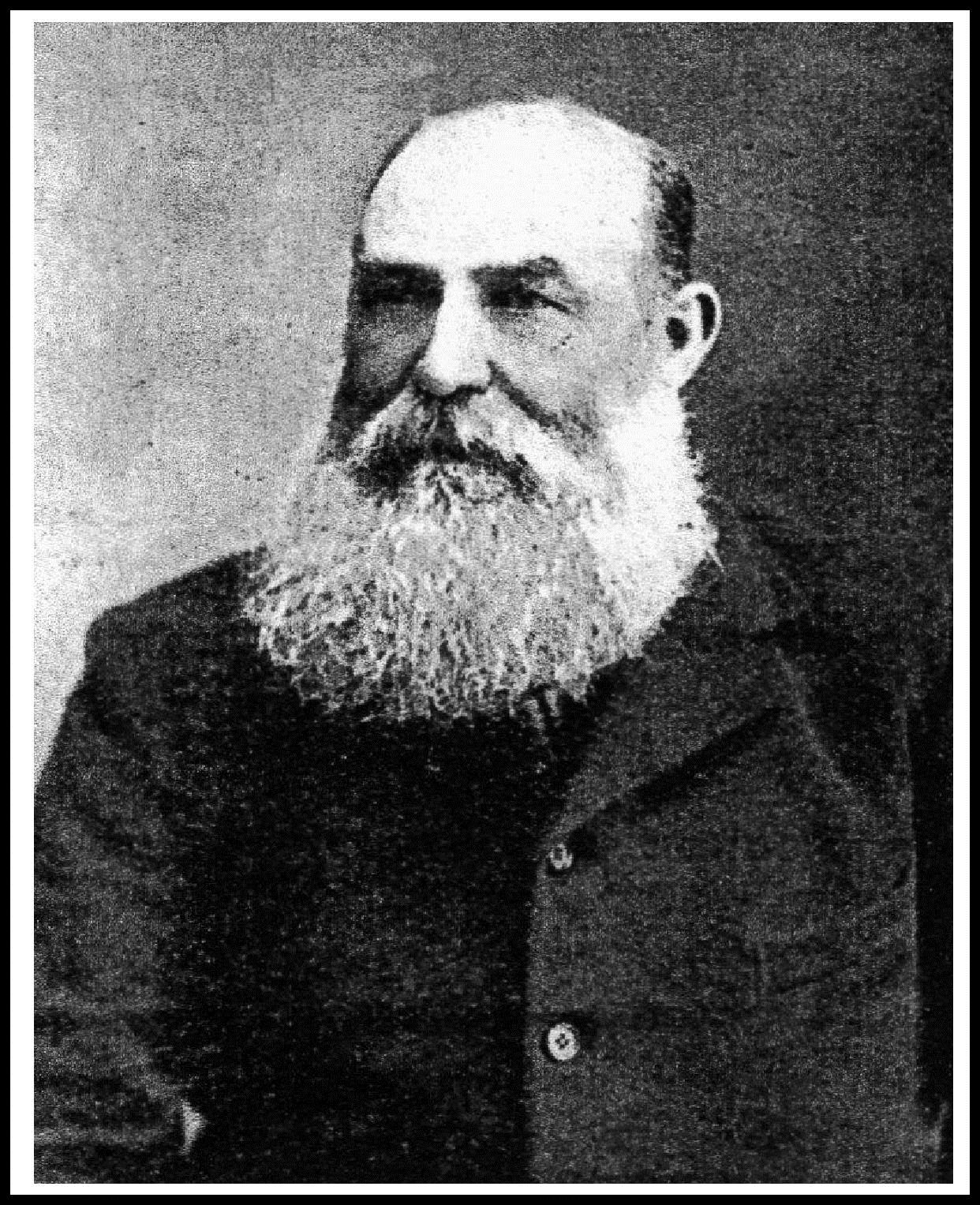
Contents
- 1 Introduction / Acknowledgements
- 2 His Formative Years
- 3 His Years at Sea
- 4 His Years in Liverpool
- 5 His Years in Runcorn - The Early Mission
- 6 His Years in Runcorn - The New Mission
- 7 The Final Years
WILLIAM SHAW Runcorn`s Renowned Missioner
1 Introduction
In January 2005, I talked to you on the subject of Temperance in Victorian Runcorn. One of the men I included in my list of people who were actively involved in the “Temperance Movement” was WILLIAM SHAW.
As a consequence of my talk, friends from Warrington
approached me last year, having discovered that one of their neighbours was a man called Peter Shaw, a great grandson of William Shaw. His grand father was William Shaw`s youngest son James who is probably best known for being the first driver of the Runcorn Transporter bridge. My friends asked me to provide Peter with the information I had found when researching my talk and, as so often happens, one thing led to another and my interest in William Shaw deepened.
With the help of Alec Cowan, I also established contact with Jean and Irvine Popplewell of Moughland Lane, Runcorn. Jean, as you may well know is also a great grandchild of William Shaw. Jean's Grandfather William, the second eldest son of William Shaw, being the Tobacconist whose shop was located at top locks where Greta Rigby`s Undertakers now is. Thus I have been able obtain much information and assistance in the collation of this presentation. I am also indebted to Bob Evans who is the Author of “Mersey Mariners” and “Mersey Mission to Seamen 1856 - 2006” who included accounts of William Shaw`s work for the Runcorn Mission in his books.
(Sadly both Jean and Irvine have passed away since this paper was written.)
I would also refer readers to a pamphlet to be found at Runcorn Library in the Local History Section:
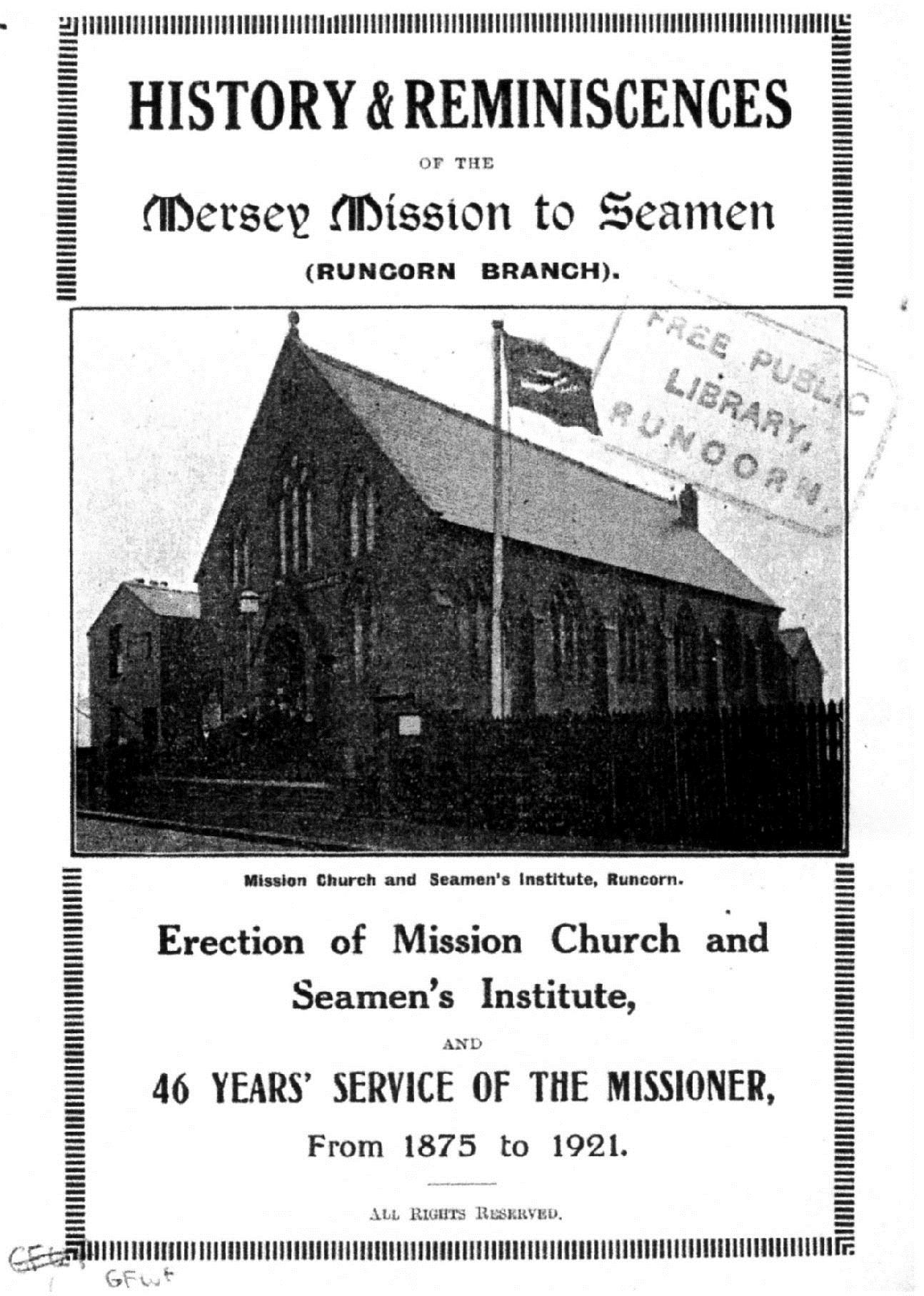
2 His Formative years
Although it was well known that he came from Upton - on - Severn in Worcestershire and that he was born on 16th September 1841, William Shaw`s birth does not appear to have been registered. However, census records enabled me to trace him as a child and subsequently to find a record of his baptism on the 8th January 1843.

Census records led me to search Upton`s parish baptismal records for 1820, when I found the baptism of his Mother Abigail Shaw.
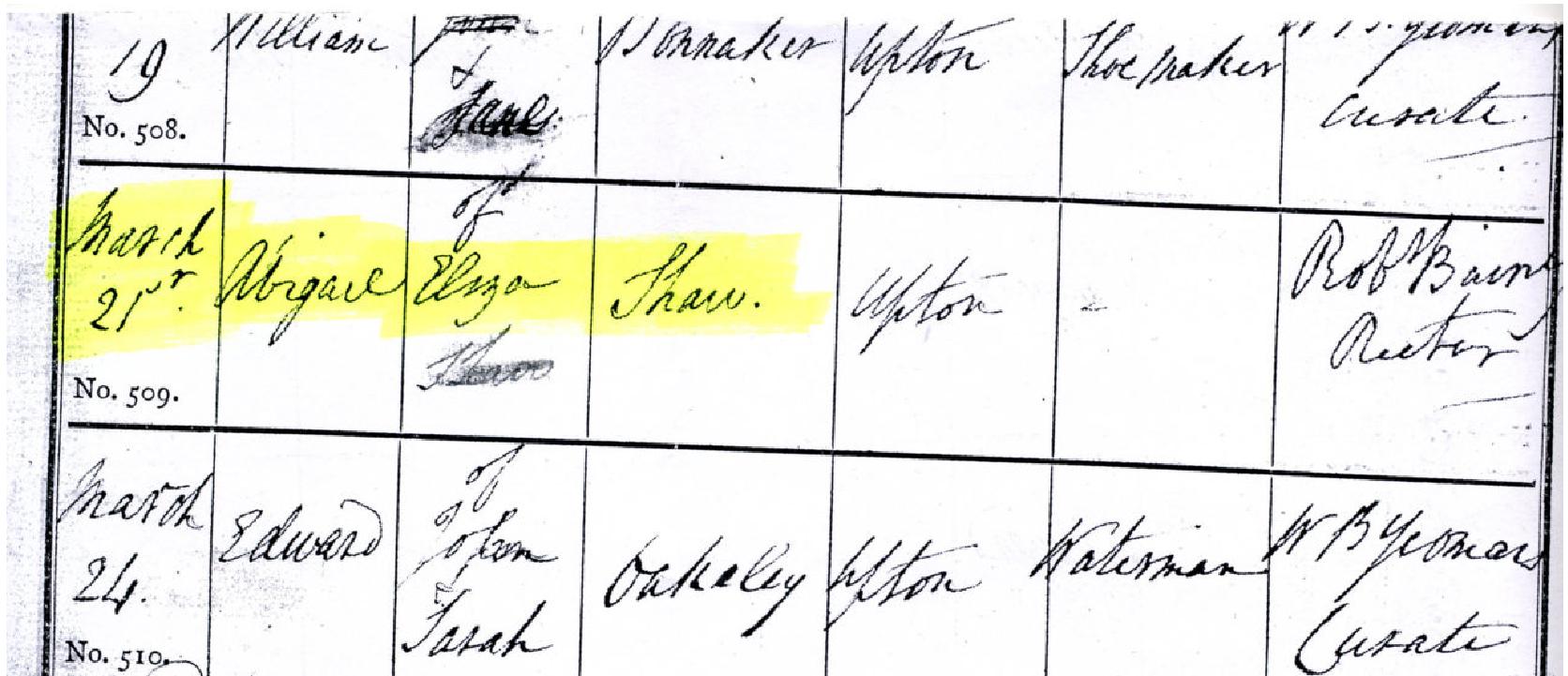
Although William`s mother, said to be a member of the local “Canal Boat” community, was unmarried at the time of his birth she did subsequently marry on the 12th June 1845 just before his 4th birthday. The wedding took place at the parish church of St. Peter The Great in Worcester as Abigail (and William?) seemed to be living there in Bath Road, near the Birmingham and Worcester canal, at the time. Her Fathers` details are unknown.
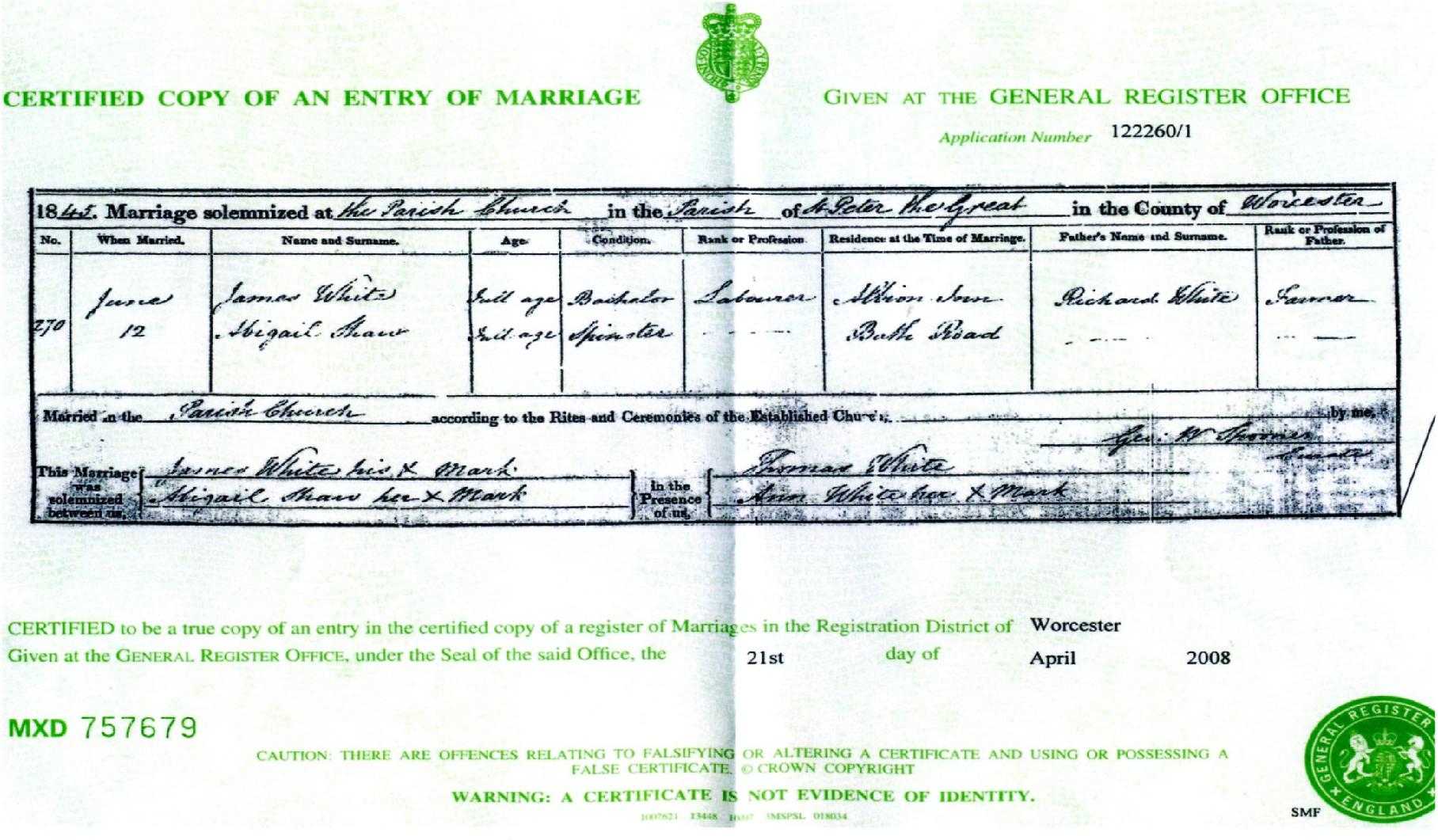
Her husband was James White, the son of a Farmer who laboured on his Fathers farm. He subsequently became a publican and moved the family to Upton - on - Severn from where Abigail and William originated. William seems to have been “adopted” by James White and on the night of the 1851 census he is found in his Stepfathers household along with his Mother Abigail and her three other children. William is described as being James`s “ Son in Law ”, 9 years of age and a scholar.
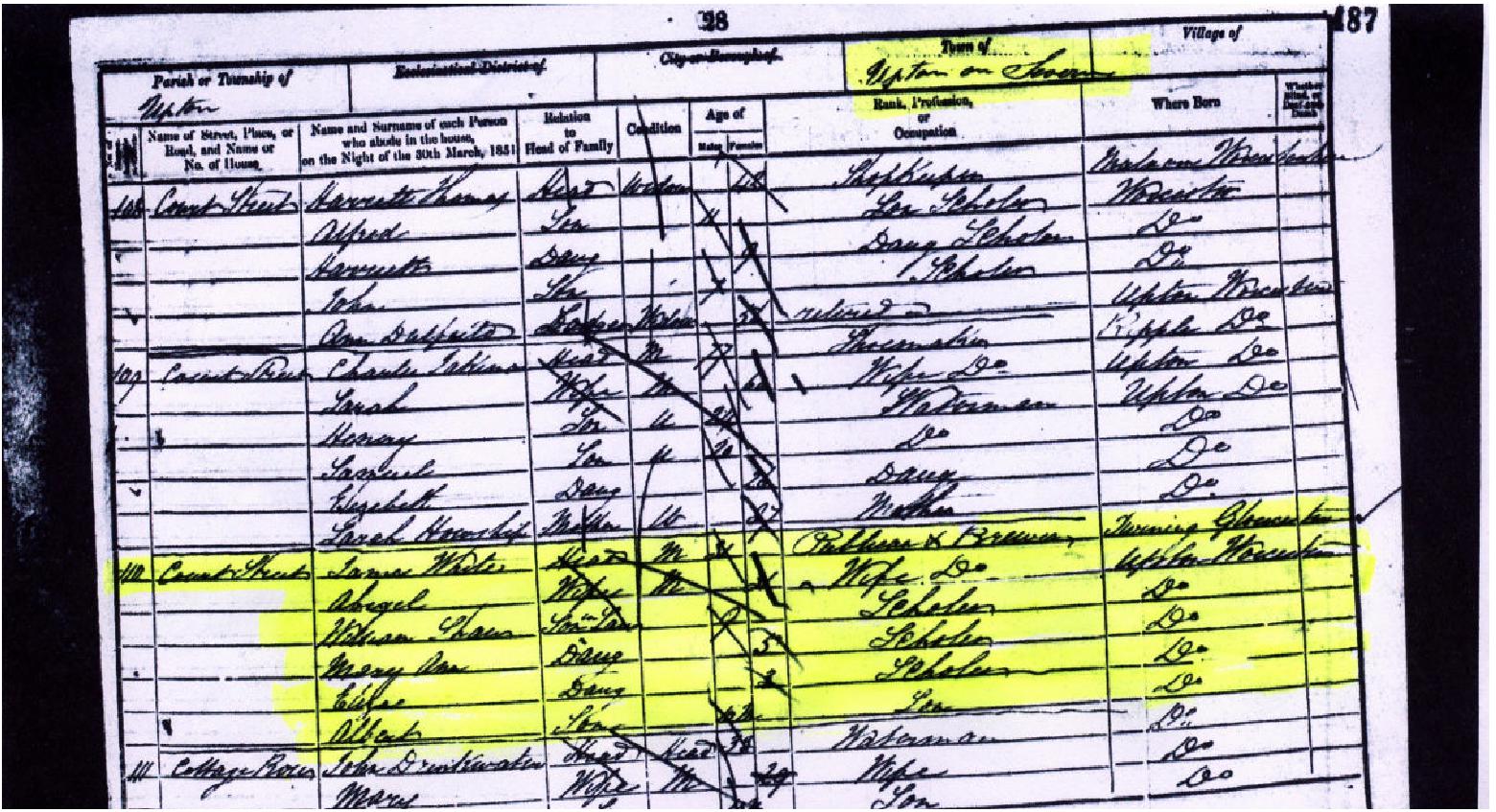
The family lived in Court Street, which is still there today:
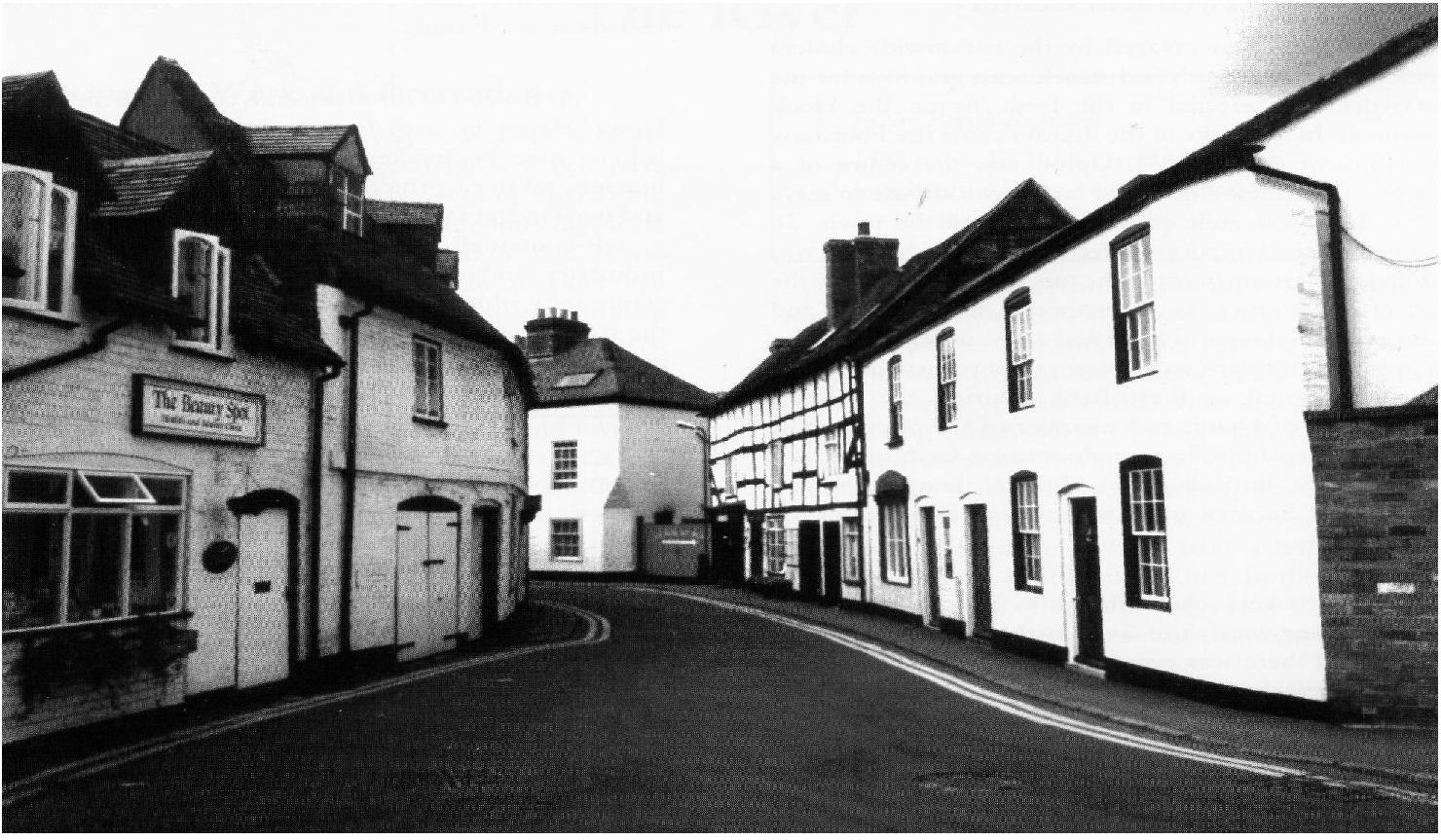
The Upton - on - Severn section of The Billings Directory and Gazeteer of Worcestershire for 1855 lists:, Brewers Arms, Berrow Fie “White James, Beer Retailer lds.”
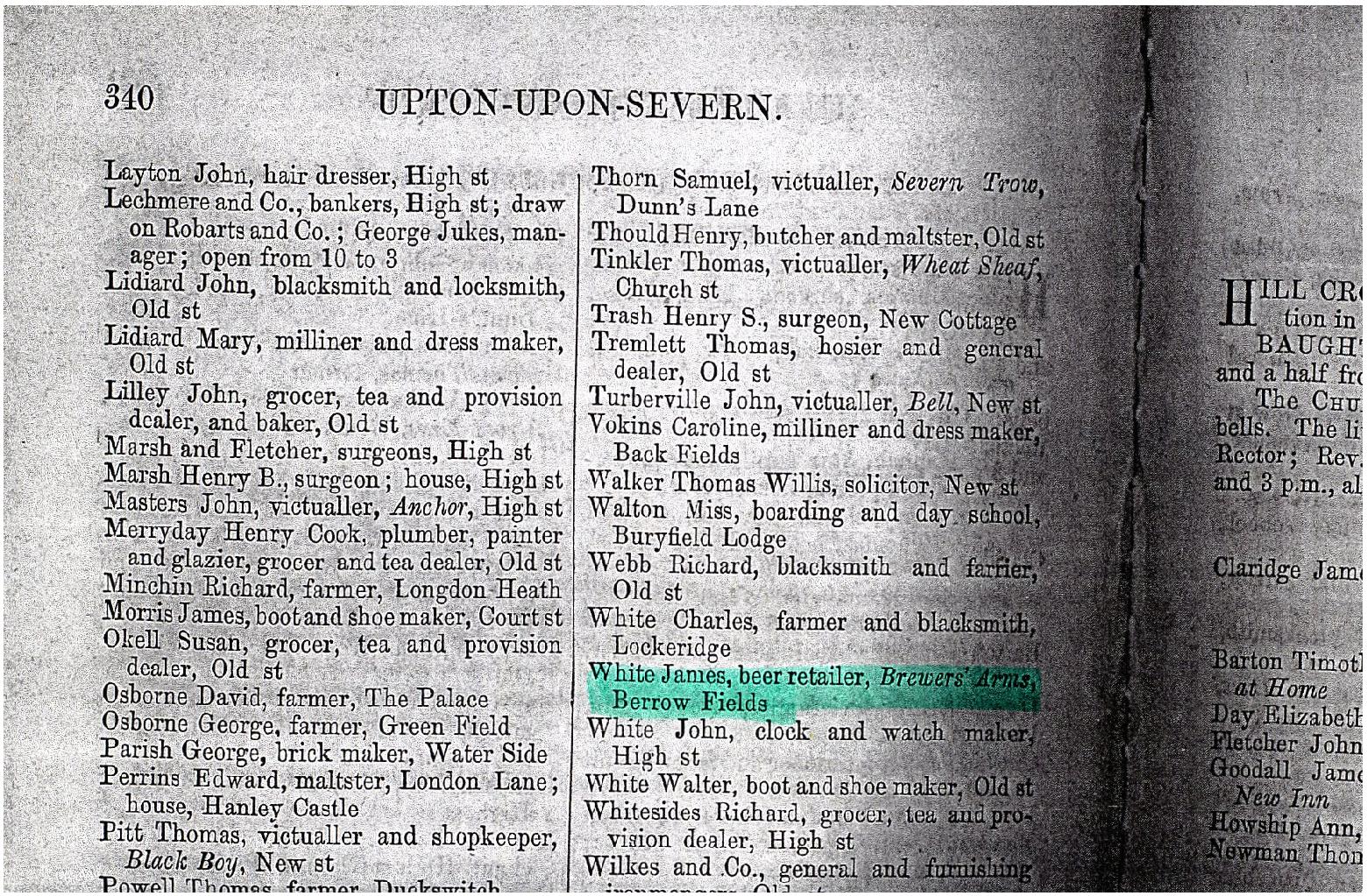
during the 1st quarter of that year. In the 1861 census William`s Stepfather James White died in 1860, his death being registered Abigail White was still living in Upton - on - Severn with 6 of her 10 children but by this time William had been away at sea for some years.
3 His Years at Sea
The Popplewells said that William worked on local canal boats before going to sea at the age of 11 (about 1853). Starting out as a cabin boy he sailed to Spain and then to Auckland, New Zealand on an emigrant vessel. Further voyages took him to Shanghai and Kronstadt in Russia. He also visited Australia where he applied for work in the bush and studied the Aborigine`s way of life and customs. Whilst in China he witnessed scenes during the TAIPING rebellion, including an attack on Shanghai (August 1860). He was on a merchant vessel at the time, a ship chartered to carry coal for the British fleet during the war, which was escorted by a French gunboat because the sea`s in that area were infested by pirates.
William later joined the Royal Navy and on the 9th August 1861 he joined H.M.S. Saracen which sailed to the South China sea on a Map making mission and then, in March the following year he joined H.M.S. Pioneer on which he served until his discharge in 1863. Whilst serving on the Pioneer he visited Melbourne, Sydney, Brisbane and Cape Town while she carried out surveys in the waters around Australia. It was whilst serving on the Pioneer that he learned of the death of Albert, Prince Consort and for the Lancashire Relief Fund he raised £60 in Australian harbours by holding concert parties.
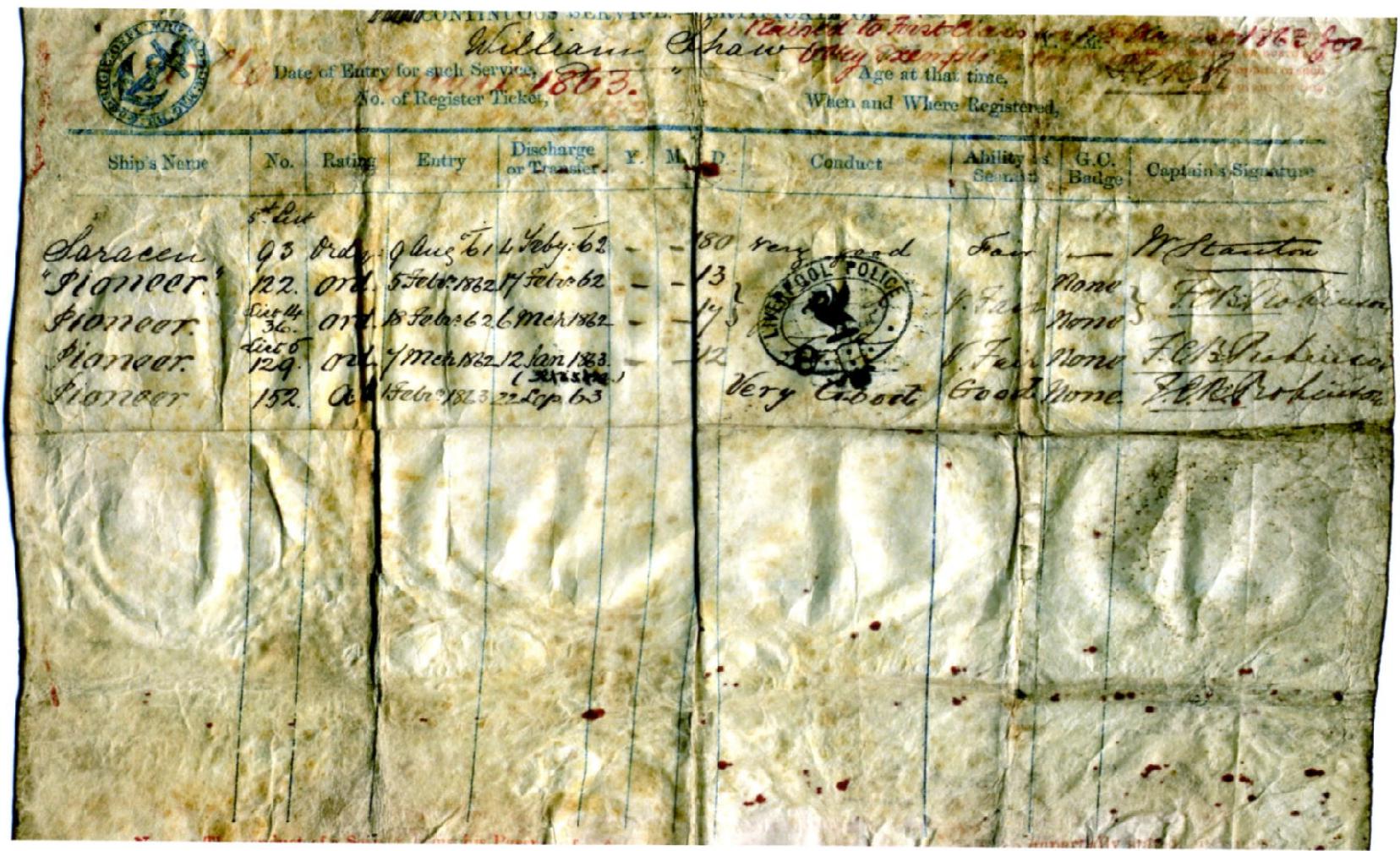
The above is an original document that refers to his Naval service and shows that he was an Ordinary Seaman 1st class who displayed very good conduct and attained a good level of ability. It also described him as a man of 5 feet 8 inches tall, of fair complexion, blue eyes and brown hair. The document also bears the “stamp” of the Liverpool City Police force, which he joined on the 6th of September 1864 as noted on a Liverpool City Police memorandum form following his resignation on 9th July 1875. This “document” indicates that he was posted to the River Police on 5th June 1865.
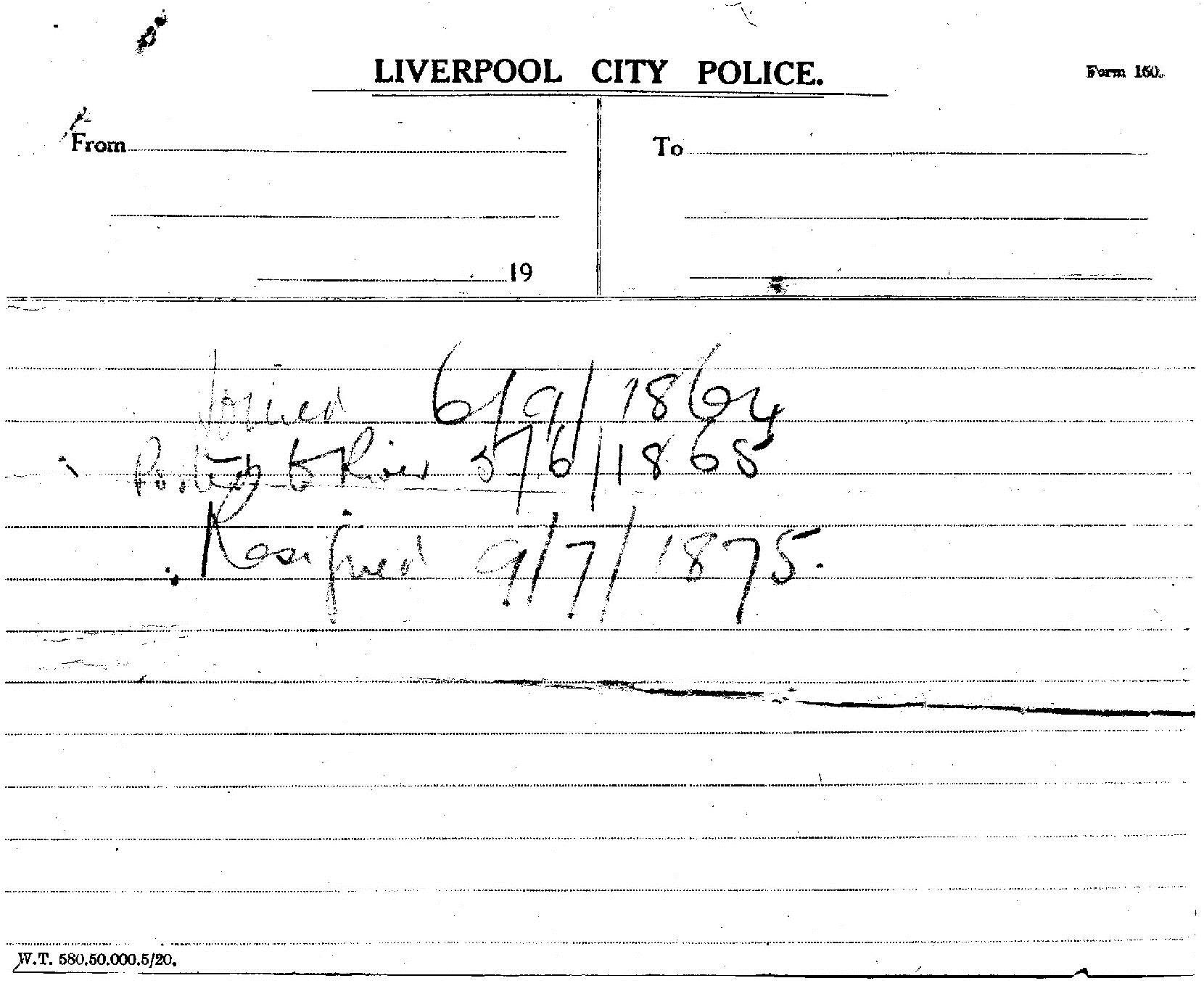
4 His years in Liverpool
Not long after arriving in Liverpool and shortly after his posting to the river police, William married Mary Quayle, a lead miners daughter from Foxdale, Isle of Man who was a servant in the home of a Jewish family called Hines that lived in Great George Street, Liverpool. They were married at St John`s Church Liverpool (where St John`s Gardens now are) on the 6th August 1865 before witnesses William and Elizabeth Hatherby. Of particular interest is that the entry records his father`s name as John Shaw, Waterman! Perhaps he was embarrassed about not knowing his Fathers name and used that name which was quite a common one in Worcestershire around that time. It may have course been the name of a relative.

It appears they found a home in Toxteth as their first child, Richard, was born during the 4th quarter of 1866 in the West Derby registration district and in the 1871 census the family, which now included William and Philip, were living at 35 Vickers Street, Toxteth and family income seems to have been supplemented by the prescence of three boarders.
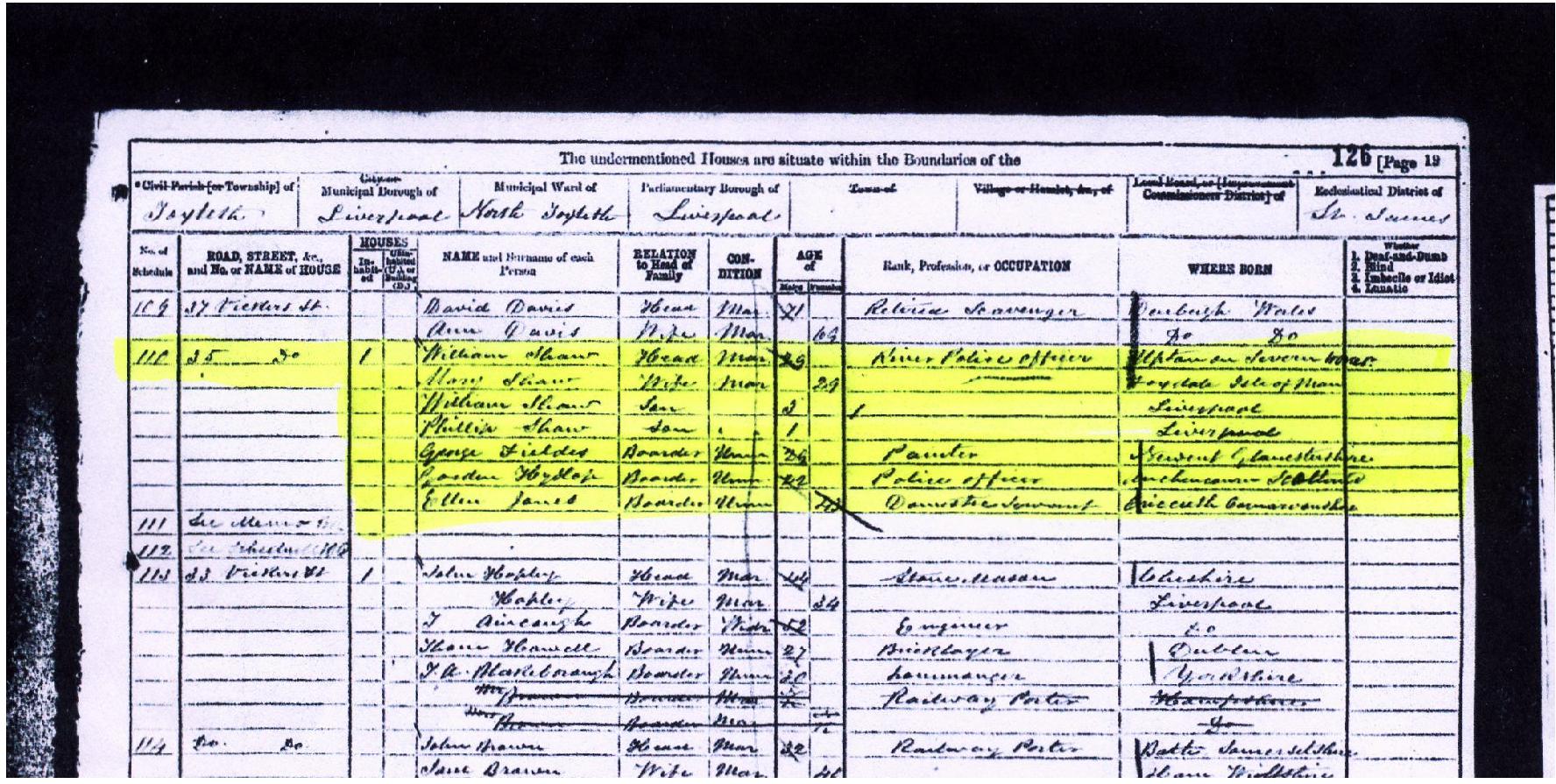
Their son Richard was not present on the night of that census because he was visiting his Grandmother, Abigail White in Court Street, Upton - on - Severn.
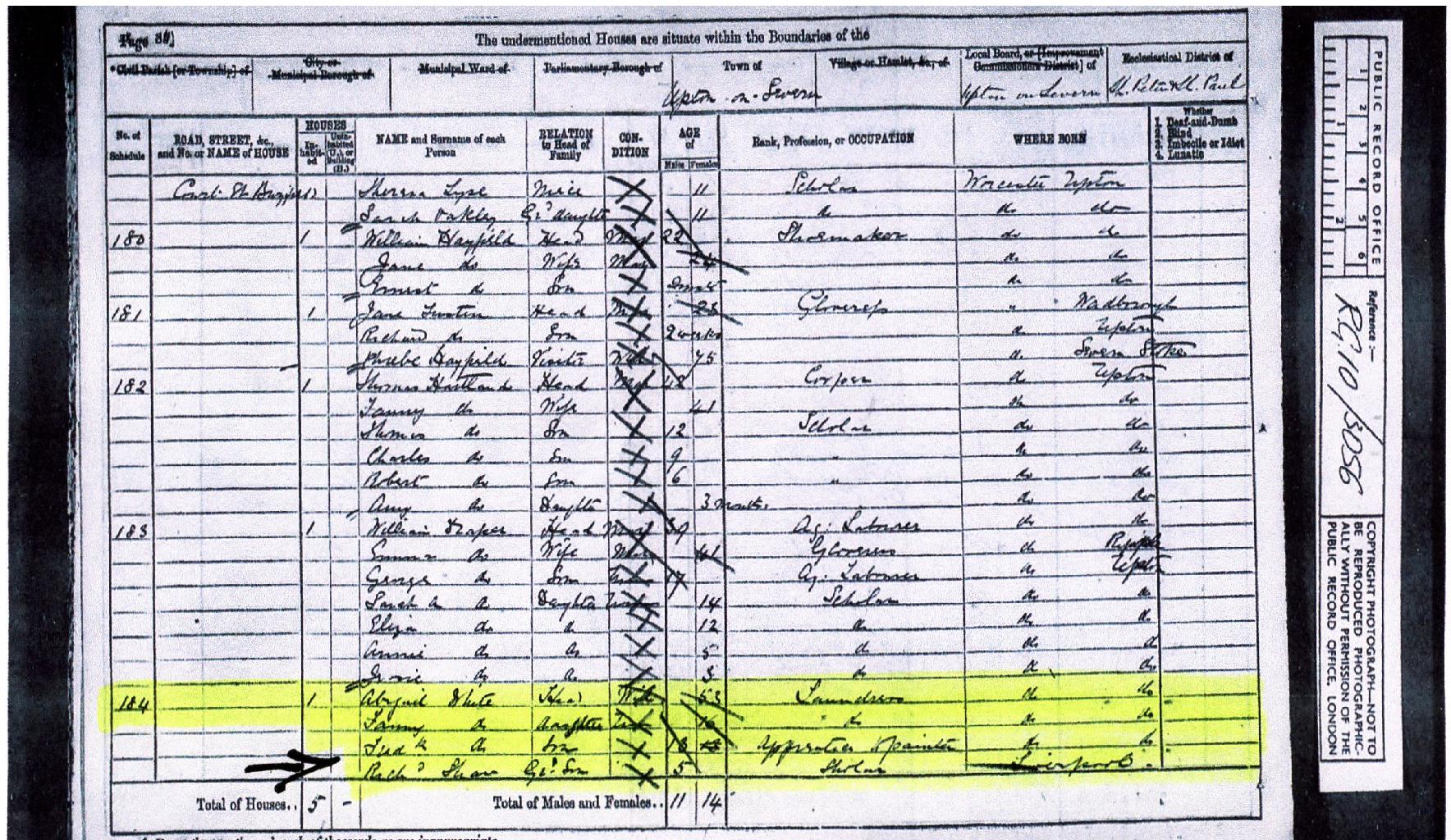
This situation clearly suggests that William always kept in touch with his beloved Mother and that, possibly in a time of family crisis he had the confidence to turn to her for help. It may be that in this context the death of their fourth child Joseph, aged 4 months, in the 1st quarter of 1871 is significant.

In July 1872, William was presented with the Liverpool Humane Societies` certificate for gallantry after saving a drowning man. An extract from the societies minute book for 1872 says:
“ To River Constable Wm Shaw, No 6, for diving into a dangerous hole (caused by the bursting of a sewer) some distance from the shore, near the Dingle and bringing out a man who had got into the hole while bathing on 27th July 1872.”
The minute book also reveals he was awarded the sum of £1. 0s. 0d.
There are of course other stories of his heroism one of which tells how: William came to Runcorn on night duty with the river police and dove into the river to rescue a woman. He then continued for the rest of his shift in his wet uniform, refusing to go off duty and subsequently went down with pneumonia. The Doctor told his wife Mary he had little hope of his recovery and told her to let him have anything he asked for! Apparently he demanded that she provide him with a hot bath. She did, and he recovered!
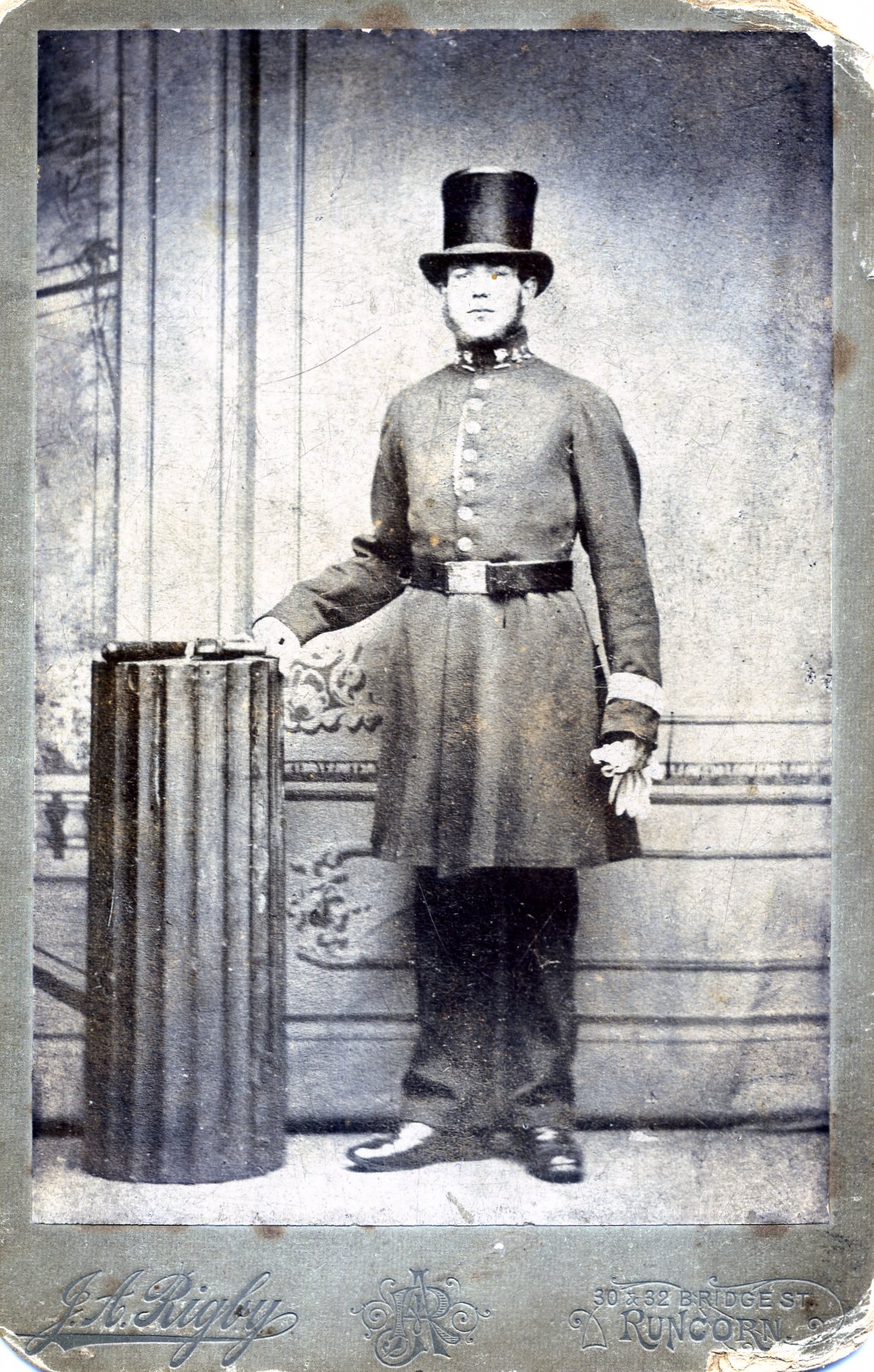
There are of course other stories of his heroism one of which tells how: William came to Runcorn on night duty with the river police and dove into the river to rescue a woman. He then continued for the rest of his shift in his wet uniform, refusing to go off duty and subsequently went down with pneumonia. The Doctor told his wife Mary he had little hope of his recovery and told her to let him have anything he asked for! Apparently he demanded that she provide him with a hot bath. She did, and he recovered!
Whilst living in Liverpool he joined a flourishing Bible class which met at St Bede`s church. When he and Mary moved to Toxteth he joined a band of Mission workers under the supervision of the Vicar of St. James`s Church, Toxteth Park. It was here that he received his training for the excellent work he was to accomplish after resigning from the river police and coming to Runcorn as The Mersey Mission to Seafarers Missioner. Sadly, just before he came to Runcorn, William`s mother Abigail White died, her death being registered at Upton during the 4th quarter of 1874.
William`s resignation from the River police was precipitated by a life threatening experience when the vessel he and some of his colleagues were on capsized in the river Mersey. He was the only survivor, thanks be to God, so when The Vicar of St James, his missionary mentor, offered him the opportunity to come to Runcorn to open a new branch of The Mersey Mission to Seamen he gladly accepted it.
By this time, William and Mary had brought two further children into the world: Ann (Born 1871) and Mary (born 1873) and Mary was carrying their seventh child, John, when they arrived in Runcorn in 1875.
5 His years in Runcorn – the Early mission
William Shaw commenced his missionary work at Runcorn in an “old disused mission room “ in the old Customs House at the ”bottom locks” of the Bridgewater Canal that had been erected about 1866 by the Bridgewater trustees. Formerly known as St Peter`s Mission, this became the centre of his ministry.
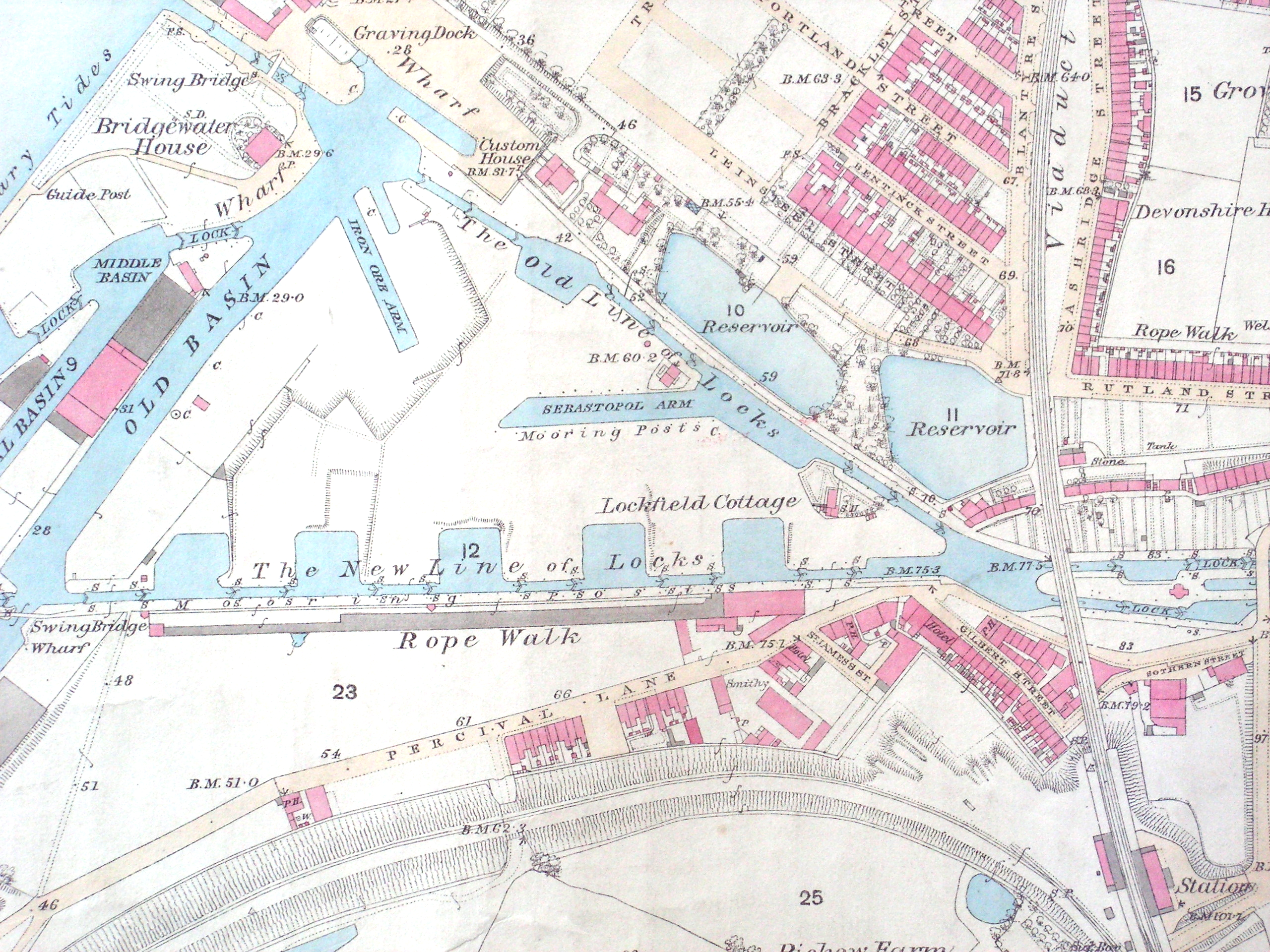
Bob Evans tells us that the missioner recruited seven young volunteers (4 boys & 3 Girls) and set about visiting boatmen and seamen in their homes and on flats and ships. In one year his visits totalled 7,447. There were thirty three Band of Hope and Temperance meetings and seventeen open air meetings conducted aboard ships and at the docks.
One report was to state that Shaw`s best work was `…. in the drivers` kitchen, where he used to address the class of people who most needed his services. On one occasion there were 75 people present. The open-air services at the docks, on board the vessels, and at the Top Locks have been the means of doing much good.
The first home address I could find for William and Mary was one listed in WORRALL`S Street directory for Runcorn for 1876;
Shaw William, scripture reader, 99 Shaw Street. In 2015 a blue plaque was placed on this house to commemorate him and his life.
Newspaper reports of the day often heralded the work of the mission and William`s efforts to relieve distress during periods of unemployment, or when work on the canals was stopped because of ice. Typical of those reports is the following from the Warrington Guardian of 17th December 1879.
“During the four days the soup kitchen connected with the Mersey Mission to Seamen has been opened, no less than 468 meals have been given away. Mr Shaw having announced that a free meal would be given away on Sunday Morning, there was a large muster and 128 children were regaled with tea and buns. Should the thaw continue the soup kitchen will cease operation after this day.”
In addition to his work developing a mission in Runcorn, William also established a Mission for Seamen in Ellesmere Port in the year of 1880. In recognition of his work in Ellesmere Port, the Committee of the Mersey Mission to Seamen at their meeting on 8th March 1881, resolved to award William a £10.00 bonus payable quarterly from the 1st January of that year.

Sadly, William and Mary`s life was not always filled with satisfaction and a sense of achievement even though their family continued to grow, John arriving just after their arrival in Runcorn, James (the transporter driver), who was born in Blantyre Street on 7th August 1877, Rebecca in 1879, George in 1880 and Elizabeth in 1881 because as the census that year revealed, George did not survive. His death aged 6 months, is registered in the 4th Quarter of 1880 at Runcorn.
By now the family were living in Percival Lane and there were nine children and a 22 year old female domestic servant from Birmingham. No doubt her efforts would have been a great help to Mary who was increasingly getting involved in William`s work.
William and Mary were blessed with two more children; Florence arriving in 1883 and Edith in 1885 thus completing their large family some of whom would also take an interest in their Fathers` work in the years to come
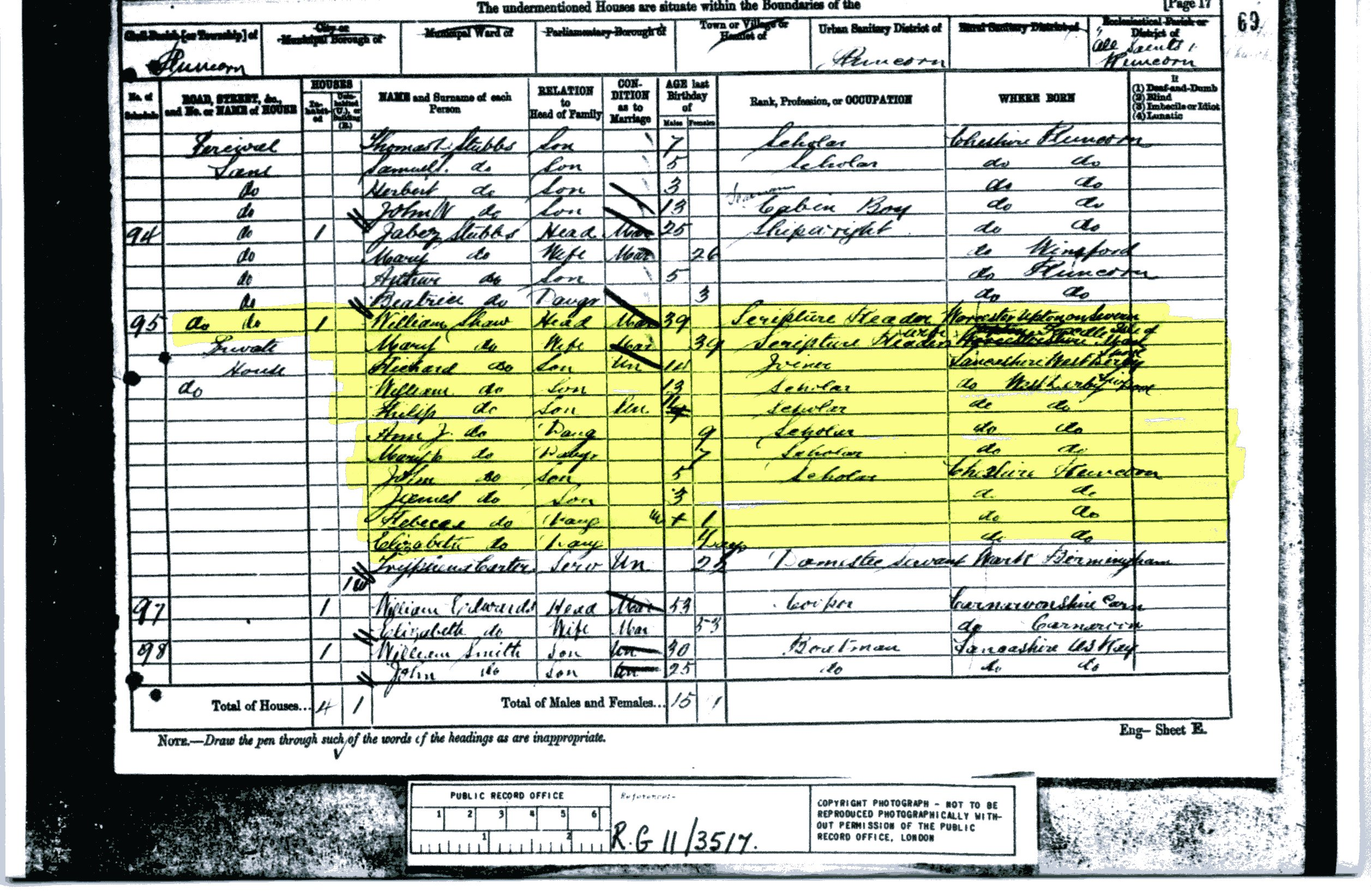
In his annual report to The Committee of the Mersey Mission To Seamen in 1890 William expresses difficulty in condensing a year`s work in one report saying that he could only give them a " brief account of the Lords Work among the people whom it has pleased God to permit me to labour for the past fifteen years"
“ I have during this year on several occasions been able to show the seamen and others that in a time of trouble, sickness and bereavement they have a true friend and helper in the Mersey Mission to Seamen. I can only give one case out of many. Our readers will recollect the terrible storm of November 7th when so many coasting vessels were lost with all hands; those who read the Mersey Mission Magazine will recollect how the body of the Captain of the schooner “Blanch” out of Plymouth, was washed up at Hoylake, and I identified it, and made all the arrangements for the funeral, which otherwise would have been undertaken by parish authorities; also through our instrumentality, and the kindness of the Rev. Canon Blencowe, Rector of West Kirby, £17 12s 6d was sent to the Widow.This has given universal satisfaction to the Seamen trading to Runcorn, and one Captain, speaking at the Annual Christmas Tea to Seamen and Boatmen, declared his intention of giving all the support he could to the Mission, as many others have said in conversation with reference to this sad case, which is proof that the Mersey Mission To Seamen has the welfare of the Seamen at heart, and do not only preach but act as well.”
He went on to give an outline of the prayer meetings at the mission room, Gospel services and Mission meetings at all the churches in Runcorn. He had held Wednesday evening Bible classes and Sunday School meetings. The band of Hope and Temperance meetings had been fairly well attended, the Cottage Meetings among Boat people well supported, several Captains of coasting vessels having assisted. He also gave accounts of “Tea” Meetings including ones at Whitsun and Christmas the latter being attended by 280 children. That years excursion was also a success. He closed the report by giving details of the Proposed new Institute for Runcorn and the relevant fund raising.
Throughout his missionary work he frequently “lamented the custom of employing women and children in the canal boats.”
By 1891 his three eldest had left the family home which by now was located at 22 Waterloo Road. Richard, a joiner had married Maggie and was living at 21 Suffolk Street, Runcorn with their son, William, an iron moulder, had married Francis Leathwood and moved to Newton (le-Willows) where their daughter Hannah was born and Philip, a blacksmith had taken lodgings in Barnton. The other notable absence on census night was that of Elizabeth, who would have only been aged 10. Her whereabouts at that time must remain a matter for speculation unless someone knows more than I do.
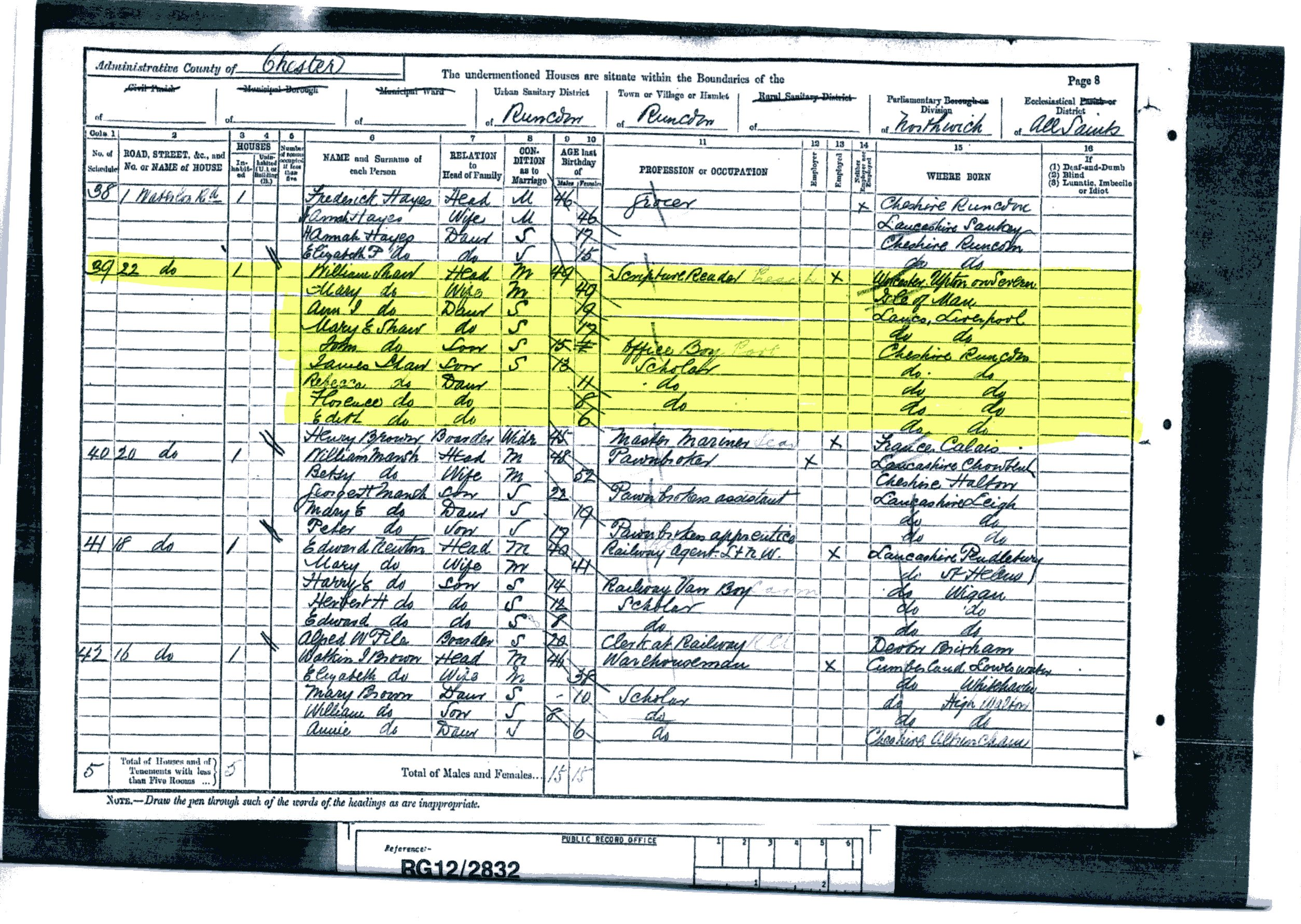
Also in the household was a Visiting Master Mariner, one Henry Brown, widower born Calais, France demonstrating their personal commitment to seafarers.
6 His Years In Runcorn - The New Mission
Of course 1891 was a big year for William and Mary whose tireless fund raising (bazzars and sales of work produced £2,125 ) and use of the slogan “Give a penny to buy a brick for the Sailors” had enabled the Mersey Mission to Seamen to start building a new Mission on land between Station Road and Stonecroft on the southern bank of the Bridgewater Canal at the bottom of Pig Lane (known as Piggy Lane).
The laying of the foundation stone on 16th April 1891 was a day to celebrate and this poster, seen at several locations around Runcorn,
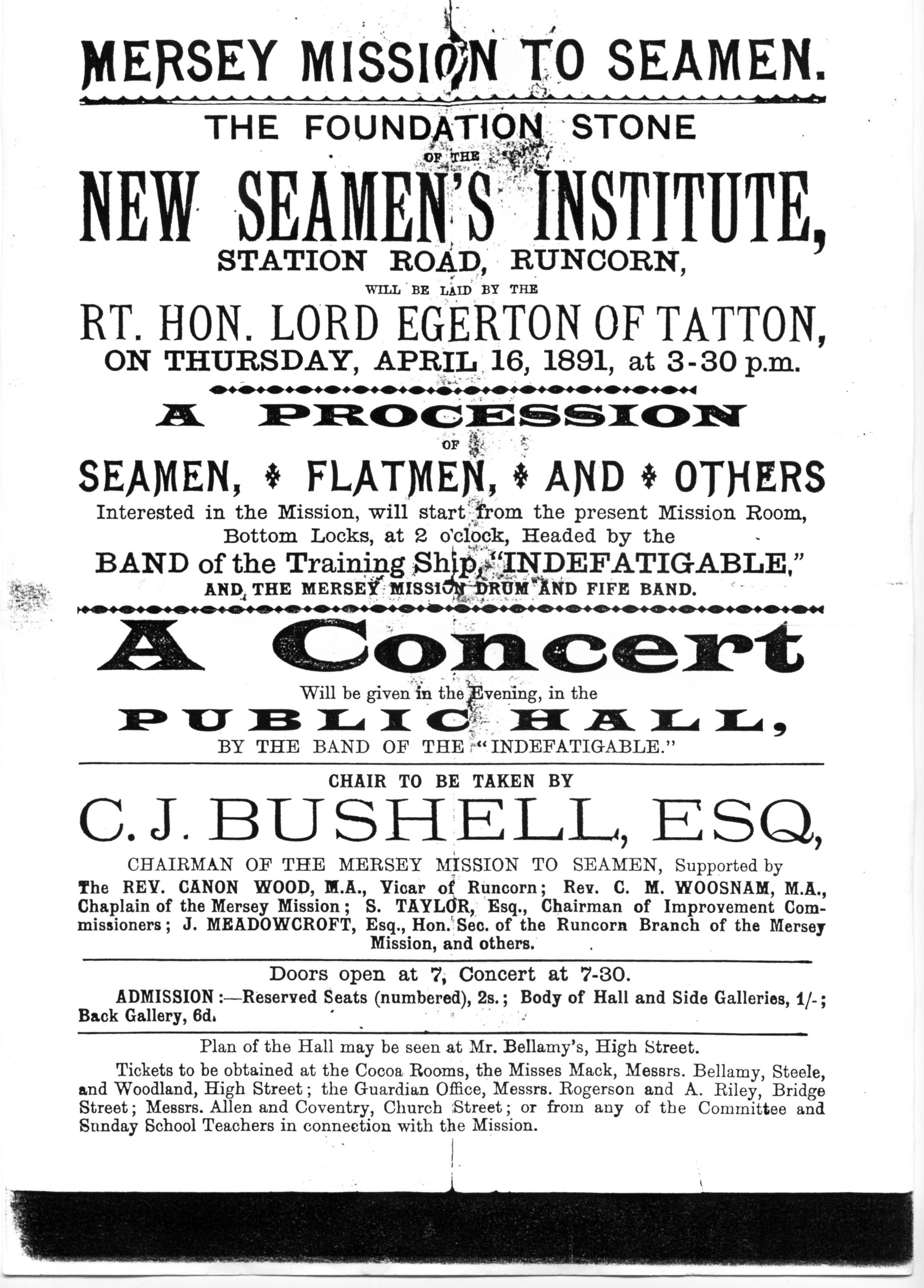
publicised the days various events, which included a procession led by the Mersey Mission Drum and Fife band and the Band of the Training Ship “Indefatigable”, who also gave a concert at the Public Hall in the evening.
The site also included land for a bowling green, a skittle alley and a recreational field for the children. These facilities, wonderful for their day, together with recreation and reading rooms in the church building, were a counter attraction to the many public houses, which had mushroomed around the docks and canal.
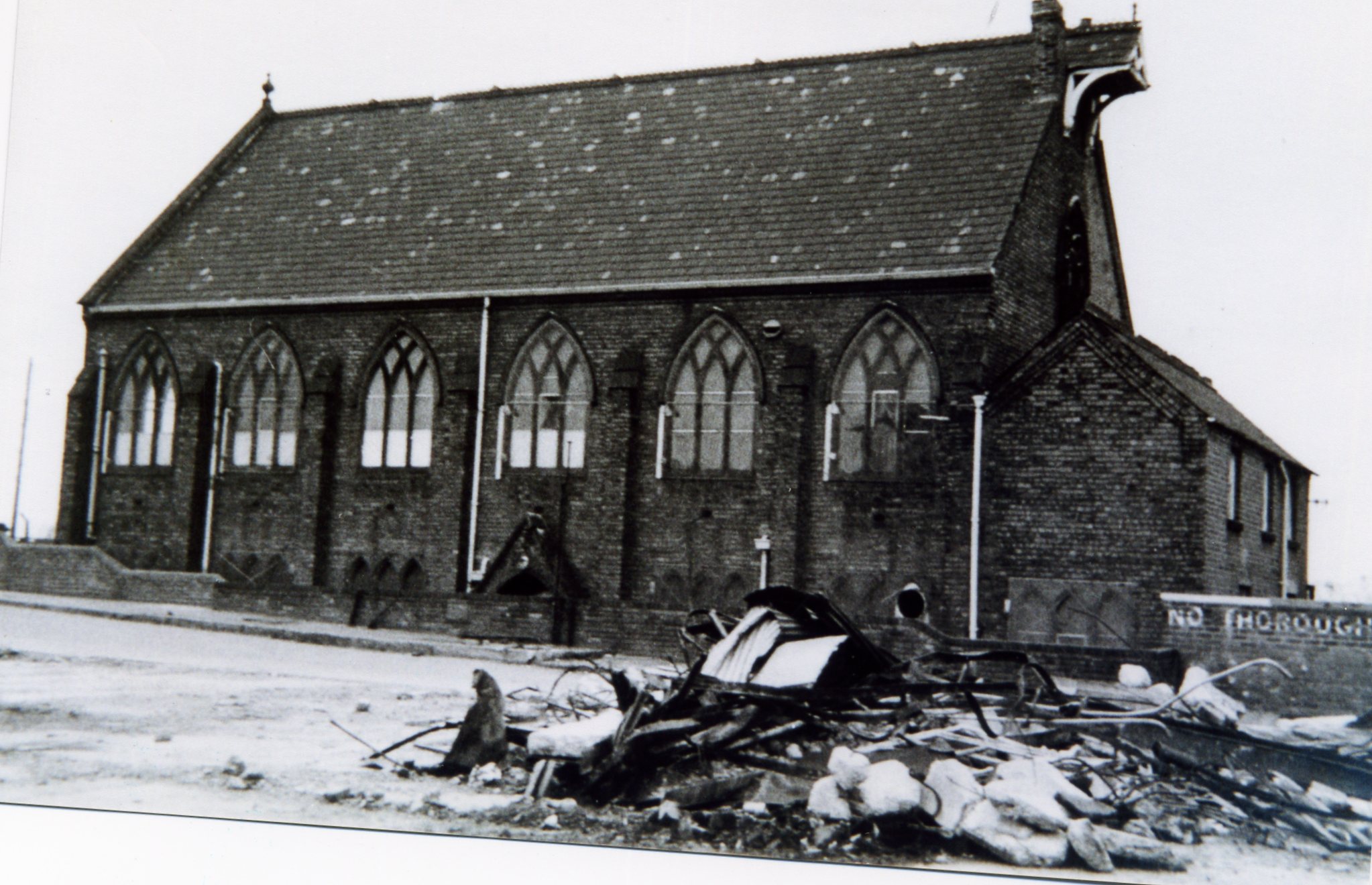
The Mission in the 1950`s before it was demolished
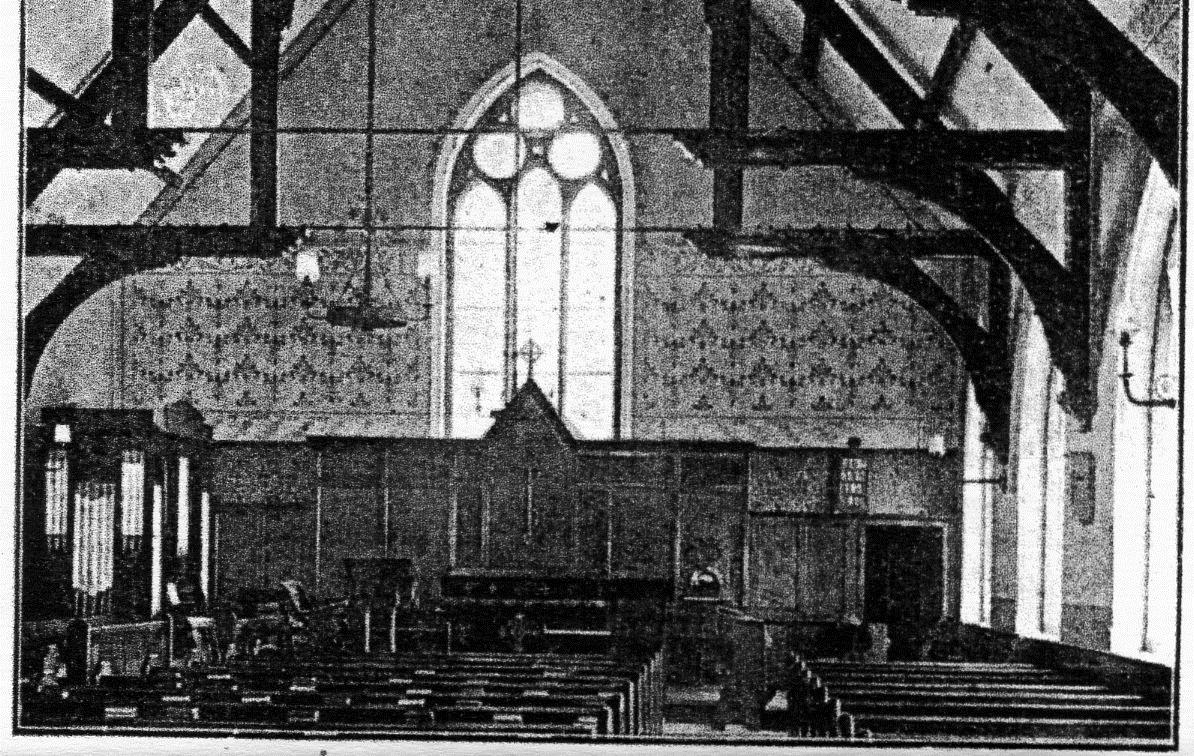
The Interior
The Mission subsequently featured in all Runcorn street directories being described:
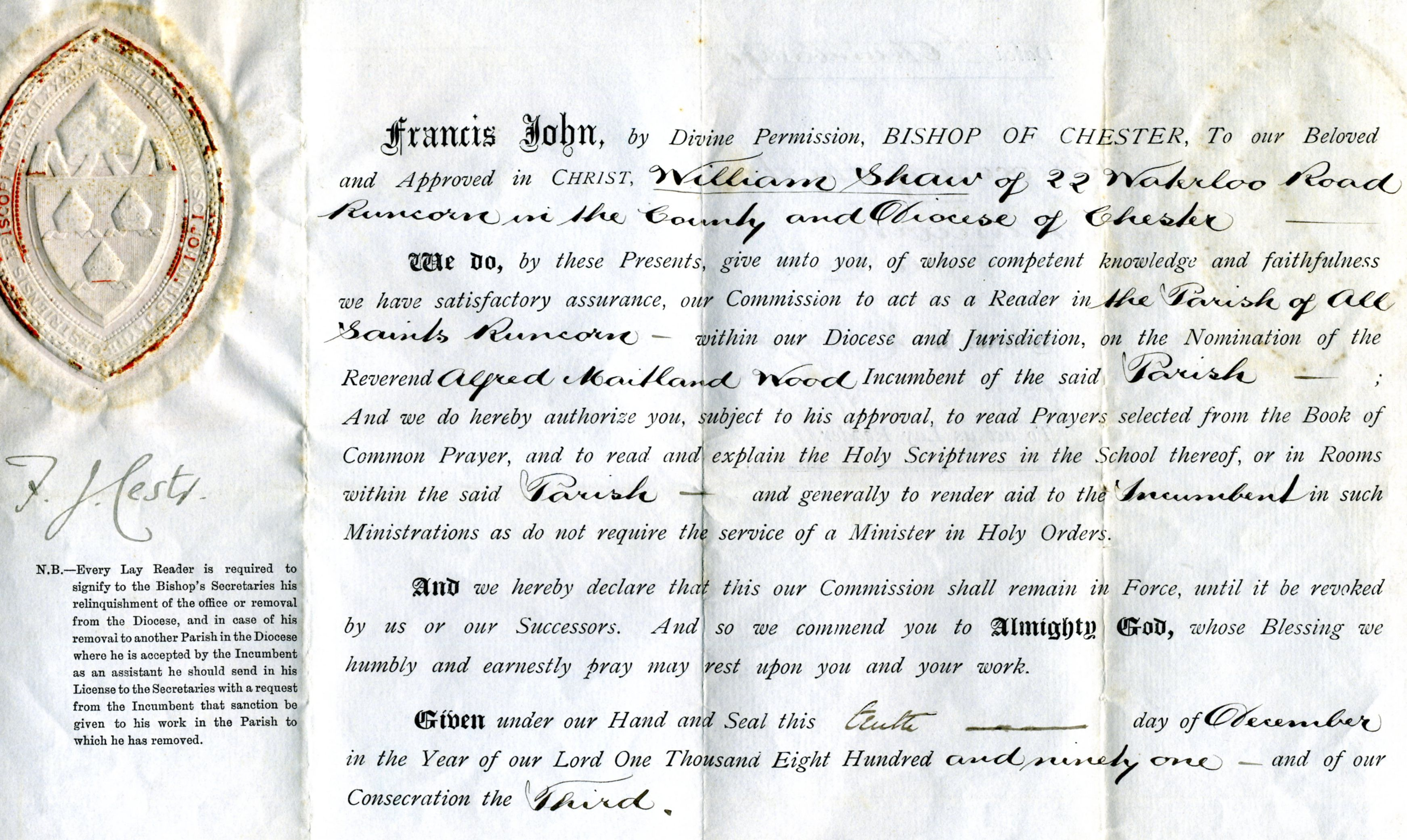
William Shaw`s Licence from
the Bishop of Chester, dated 10th December 1891
Inspite of his efforts drunkenness continued to cause unstable sailors and boatmen to fall into the docks and drown, so many in fact that William instigated the formation of a “grappling corps” to find and retrieve bodies. Indeed, the Corps was to continue operating long after his retirement and death. Indeed, there were reports of it`s activities as late as 1931. Often there was no money to defray burial expenses and so the unfortunate seamen were buried in unconsecrated ground. This affronted William Shaw so he set about raising money to buy land and erect a memorial in Runcorn Cemetery.
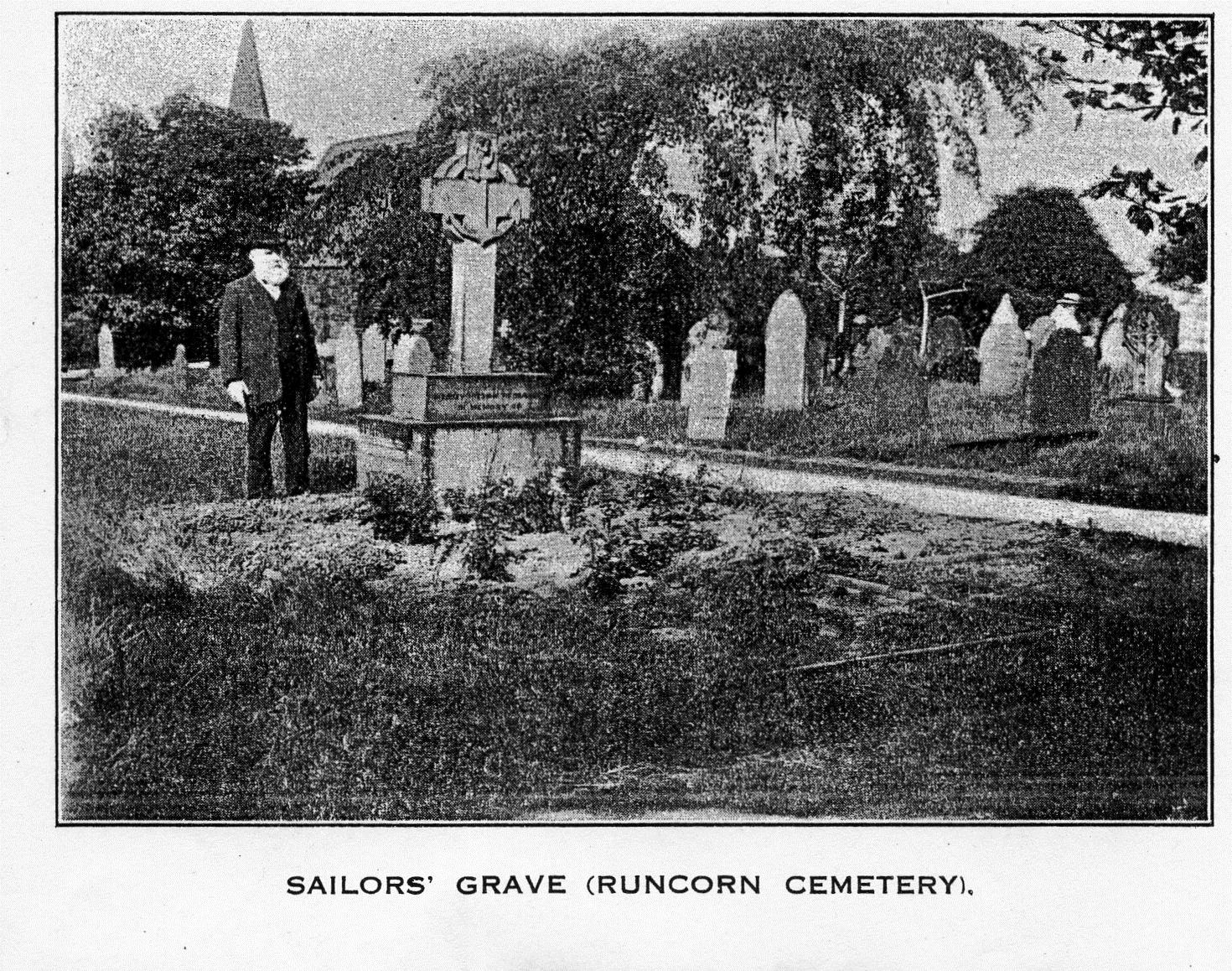
William Shaw and his Seamen`s Memorial
By the time of his retirement in 1922, 47 seamen had been buried there, in what is still known as the “Seamens Grave”. The Stone commemorates seamen from Dublin, Anglesey, New Brunswick, Bordeaux, Norway and the United States and can still be found in Runcorn Cemetery. Having been dismantled, presumably for safety reasons, it has now been rebuilt by public donations and rededicated, due to the efforts of Mr. Roy Barlow, himself a former member of the Merchant Navy.
By 1901 more of William`s children had flown his nest at 22 Waterloo Road and on the night of the census only 3 remained at home: John, Florence and Edith.
Richard was living at 35 Waterloo Road with Maggie and their two children, William jnr. was in the High Street with Frances (Leathwood) and their two children, Philip was living in Halton village with his wife and Children, James and his family were at South Parade Weston, Elizabeth was in Handley Street with her Husband William Crabbe, Ann was with her Husband Thomas Whitfield in Walton On the Hill, Liverpool whilst Rebecca was in service in the home of a Manchester Merchant in Chorlton cum Hardy.
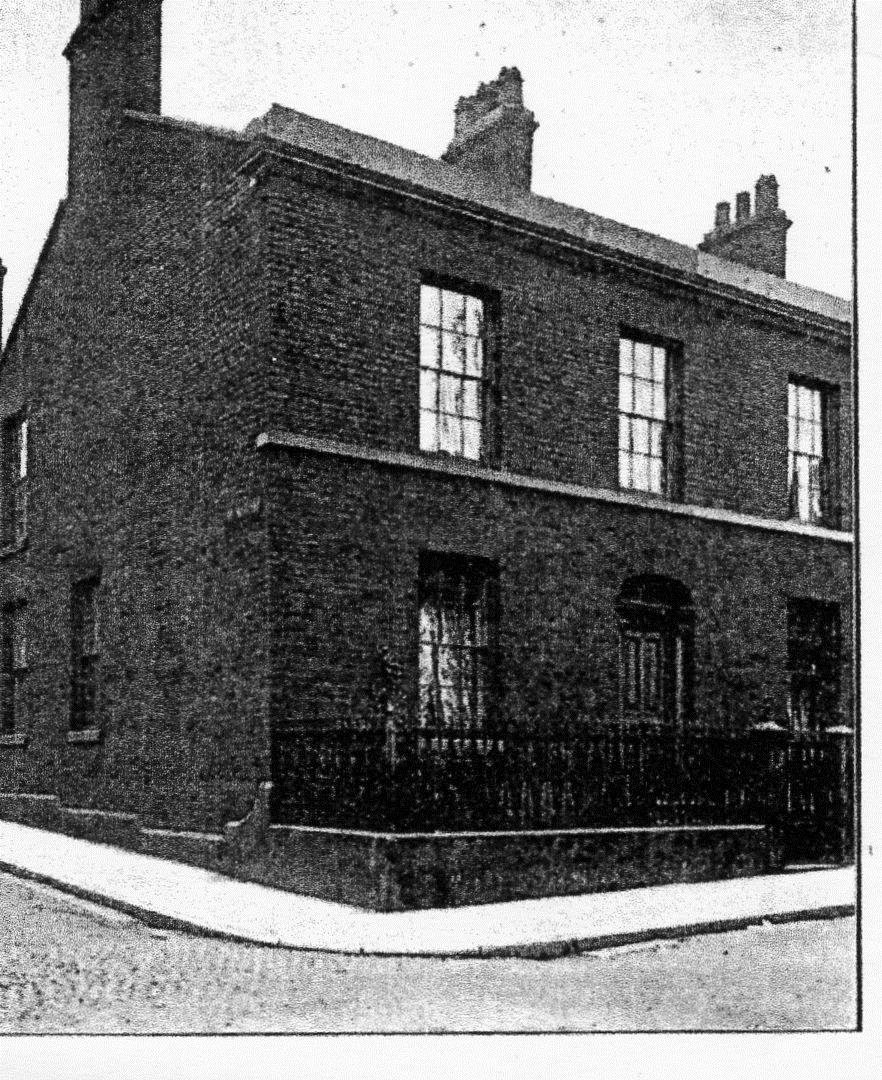
It was probably just as well since by this time 22 Waterloo road had become a seaman`s Hospital where Mary Shaw, William`s very able and supportive assistant was nursing sick seamen back to health. How she coped with this and raising her family could only be described as a “miracle”. It was not surprising therefore, that William began supporting the funding, planning and building of the Victoria Memorial (Cottage) Hospital on the corner of Penn Lane and the Holloway, which was opened in 1903. One of his fund raising events was a May Queen Carnival and the Popplewells tell me Jean`s Auntie Lilian was the first May Queen.
The Shaw`s Cottage Hospital at 22 Waterloo Road, Runcorn
In 1908, William`s fellow workers decided the time had come to bestow on him a mark of their affection and respect for 33 years of the Lords work in Runcorn. A public collection was made as a result of which a beautifully framed “Carbon Portrait “ of him was placed in a prominent position in the Mission. The unveiling ceremony was performed by Lady Brooke, one of William`s most ardent admirers. The Chairman presiding over a very large gathering, when opening the proceedings said “when Mr Shaw was appointed to Runcorn the moral condition of the floating population of the town was not high”. In reviewing the good work done by their Missioner during thirty years he was prompted to ask whether his name and work were not worthy of being handed down to posterity. He personally said it was, and without doubt the one hundred and twenty subscribers to the memorial endorsed the sentiment. Unveiling the portrait made by Mr Kirkman, amid hearty applause, Lady Brooke said she was pleased to perform the task because her friend Mr Shaw had been a true and good friend to all of them. The Rev. Canon Lambert, Superintendent Chaplain, whilst proposing a vote of thanks to Lady Brooke recounted on a recent visit to Cambridge for a conference whose delegates were convinced Mr Shaw was the “Bishop of Runcorn”. He also went on to report that when ever he went among sailors who had been to Runcorn he found they all knew Mr Shaw, and most of them knew the Institute as a result of Mr Shaw`s invitations to attend services and entertainments. In this context it is easy to see how the Runcorn Mission became known as “Shaw`s Mission”.
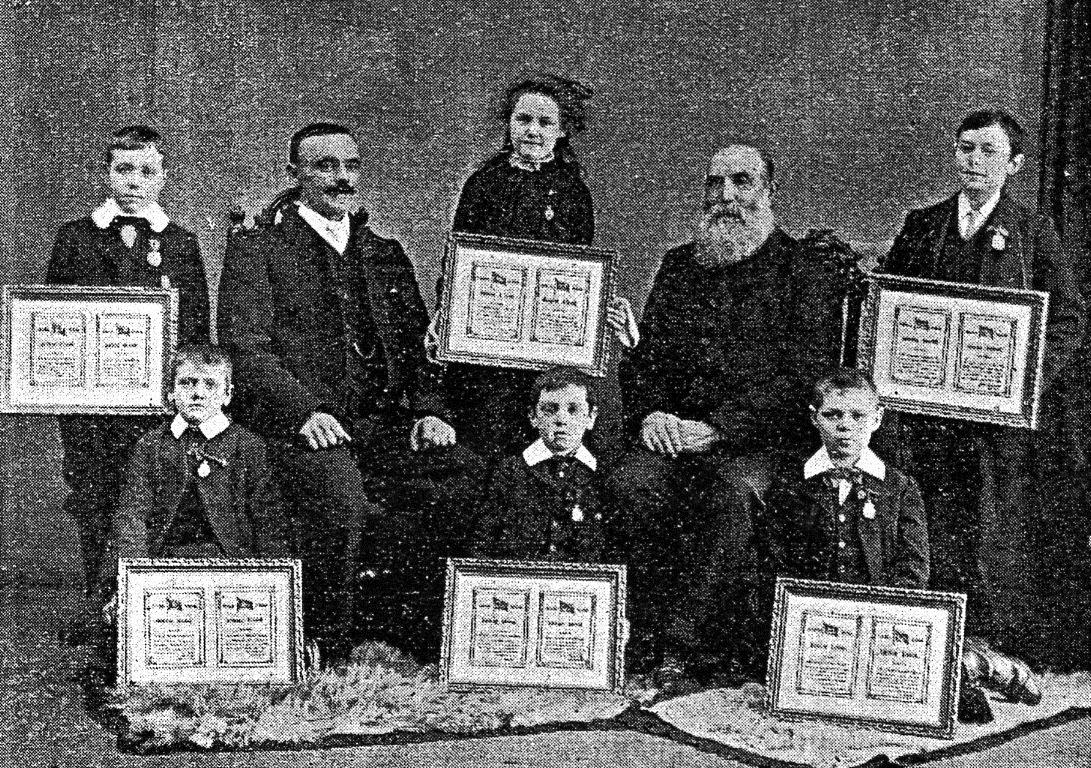
Sunday School Group (Prize Winners)
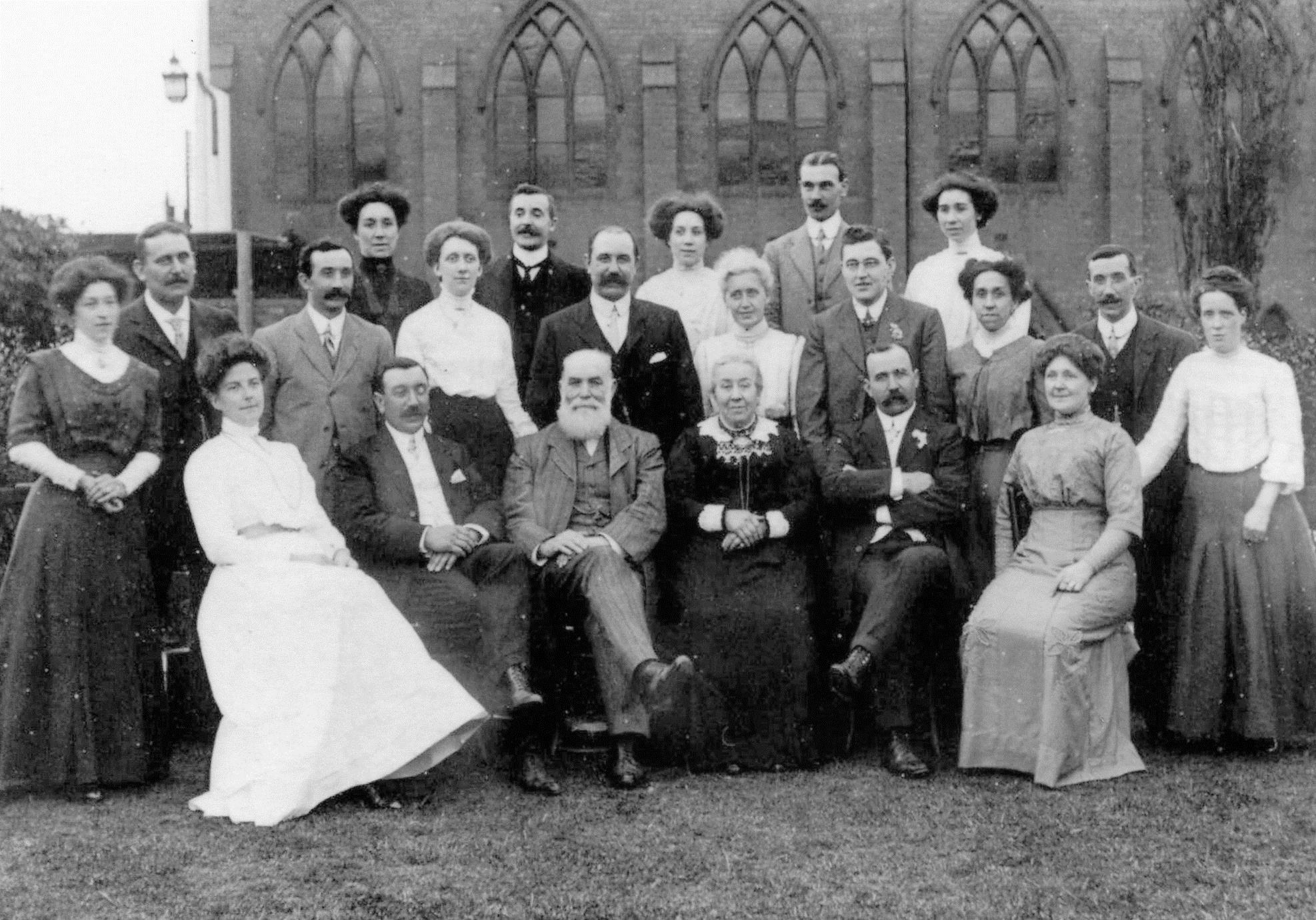
This family Photograph, taken in 1911 outside the Mission Hall features: Back Row Rebecca Shaw, Tom Deane, Florence Shaw, William Jones and Edith Shaw Middle Row Elizabeth Shaw, William Crabb, Jack Shaw, Jessie Shaw, Philip Shaw and Wife Matthew Kitchen, Mary Shaw, Jim Shaw and Frances Shaw Front Row Margaret Shaw, Richard Shaw, WILLIAM & MARY, William Shaw and Frances Shaw
William and Mary continued to work tirelessly for the seamen and boatmen as they passed through Runcorn Docks and waterways for several more years until, sadly, Mary passed away. Following her death on 8/2/1913, a stained glass window was erected in the Mission Church and dedicated to her Memory.
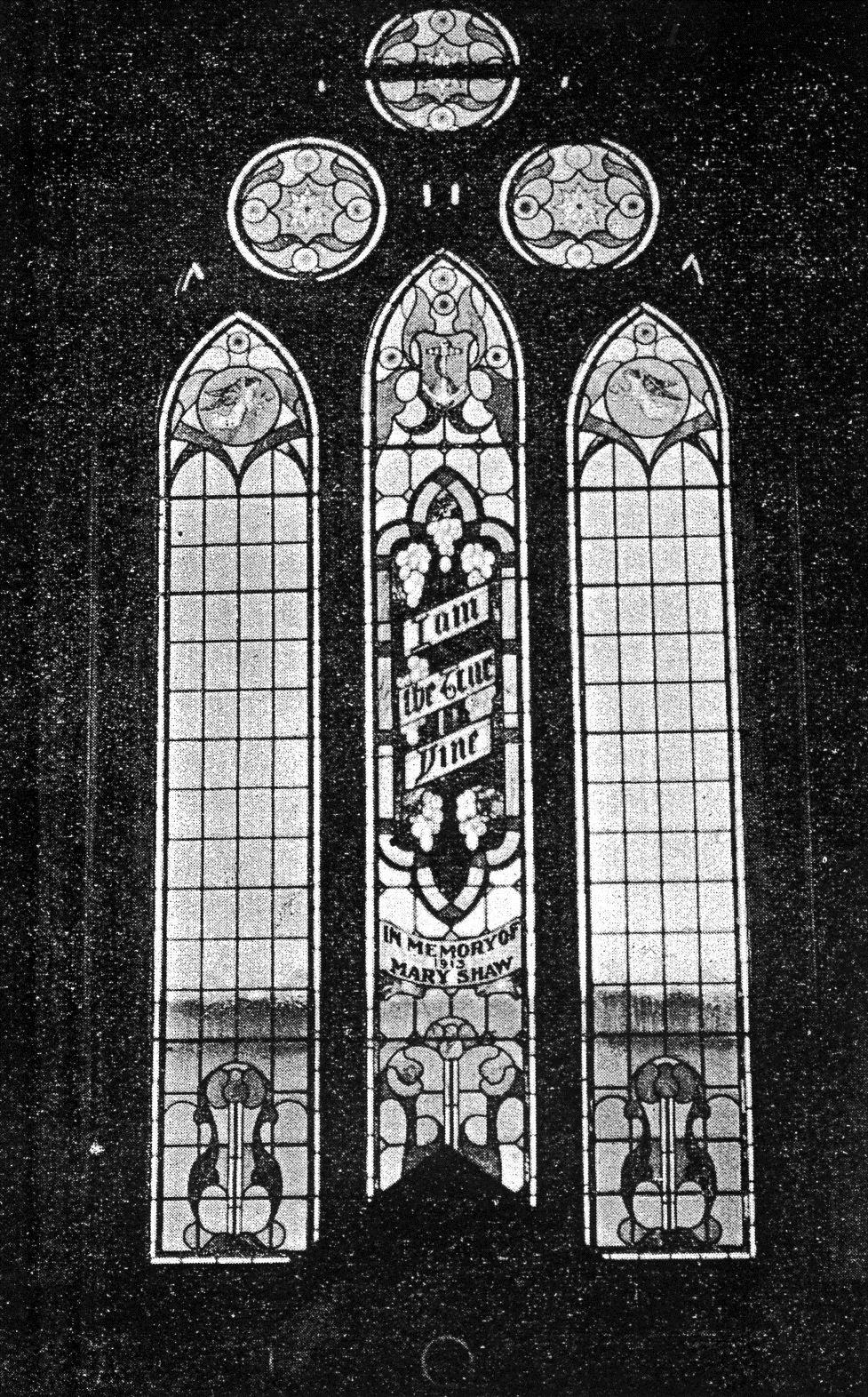
Memorial Window
I AM THE TRUE VINE
IN MEMORY OF
1913
MARY SHAW

Mary Shaw
The Parish magazine for March of 1913 says:
“During the past month the Runcorn Branch of the Mersey Mission to Seamen has sustained a great loss by the death of Mrs Shaw, wife of the most respected Missioner. The deceased Lady had endeared herself to a multitude of friends, including many unfortunate seamen and watermen, during sickness and distress. She was of a calm and loving temperament, foremost in good work, a woman of strong faith, an exemplary wife and a blessing to her children. Time can never eradicate the result of her Christian influence and charity, and although she will be missed by all who knew her, we are assured that great will be her gain.
Well done good and faithful servant”
The Window was Dedicated during a Service at the Mission Church on the 29th May 1913 All that remains of the Memorial can now be found in St Michael`s Church Vestry in a window overlooking Eaton Street. A Plaque in the windowsill is dedicated to Mary Shaw`s memory. The plaque reads: THE MEDALLION IS PART OF A STAINED GLASS WINDOW ERECTED TO THE MEMORY OF MARY SHAW A ZEALOUS WORKER AT THE MERSEY MISSION FOR 38 YEARS.
Following Mary`s death William continued to strive on behalf of his “flock” and this was reflected in another minute of the Mersey Mission to Seamen`s Committee dated 2nd April 1914 which reads:-
" Mr Shaw`s report mentioned a shooting competition which he had got up at Runcorn which realized £4 for the funds. A feature had been the shooting for a prize of a knitted petticoat made by H.M. the Queen."
At another committee meeting on 7th May 1914 another of William`s reports is referred to:-
"Mr Shaw reported that Miss Constance Brooke has kindly presented a handsome Silver Chalice and Oak Case in memory of her Mother Lady Brooke."
On the outbreak of war he joined the ranks of the special police, where his previous experience would prove invaluable, but still managed to carry on with his missionary work. In October 1914 he visited Saint Augustine`s College, Cambridge and was introduced to the Arch Bishop of Canterbury as the oldest Lay Reader amongst sailors in the World. Work around the Mission Church continued and in 1917 the Children`s recreation field was made into allotments which enabled his workers to grow food for distribution to his flock. In March the same year the Grappling Corp retrieved the body of Capt. Pratt of Weston Point from the docks and he was buried in the Sailor`s Grave. The funeral party attended the Mission in the evening.
After the war he carried on organising fund raising and entertainments. In particular, his Whit Tuesday day trips down the canal to Liverpool and New Brighton on a borrowed Wallasey Ferry Boat were memorable - the fare was two shillings for adults, one shilling for children and it was well patronised – profits, if any, to the Mission Funds. The ferryboat arrived on the Whit Monday evening and moored in the front of the “big house”, Bridgewater House. Although these trips were discontinued by the Mission, they were taken over by the Weston Point Silver Band who maintained the tradition for several years. Even so, the trip continued to be referred to as “Shaw`s Boat”.
Later, at a committee meeting on the 1st December 1920 the issue of William`s age was discussed. Although he had not in anyway indicated that he had reached an age at which resignation was desirable – although he was 79 years old, it was felt that the Chaplin Superintendent should approach him to test out his feelings on the subject. As we know, William did retire 15 months later.
A newspaper report of September 1921 describes at great length a celebration of William`s 80th Birthday which was held at the Mission. The article referred frequently to all his achievements, which were known the world over, and pointed out that he was reputed to have been the oldest special constable in the country as well as being the oldest known Missioner for the Mersey Mission to Seamen.
7 The final years
Although I have not made mention of it so far, the weekly news of Friday 3rd of March 1922, in a report about William Shaw`s Final Sermon given on Sunday 26th February at the Mission in Station Road, refers to his second wife. During his address he spoke at length about his work and devotion to God and also praised the work of several people who had supported him. He confessed that he would not have succeeded but for the help of his finest worker, his first Wife Mary to whose memory the stained glass window in that church was raised. He then went on to speak about his second wife who had been laid to rest in the cemetery only the day before! Apparently she had been a great worker at the mission for forty years and a great companion of his first wife. An extract from the Runcorn cemetery burial records which I show below reveals that she too was named Mary and confirms that she was buried on Saturday 25th February 1922. The eagle eyed among you may also spot the entry relating to his first wife.
When I gave this talk to the Runcorn & District Historical Society in January 2009 details of Williams` marriage to his second Mary were something of a mystery. I could find no record of the marriage in Runcorn, Widnes, Warrington, Liverpool or West Derby so I assumed they were married elsewhere. The question was, where? And so I asked if anyone had any ideas?
Two months after the talk, a Ruth Whitfield-Green of Runcorn telephoned me saying that she was a descendant of William`s eldest daughter, Ann, who had married Thomas Whitfield around 1893. Ruth said she had a certified copy of her Great Grandfathers marriage to Mary Hulme, nee Warmsley on the 13th April 1914 at the Parish church in Wigan. It is thought Mary Hulme may have been Housekeeper for William and his first wife Mary.
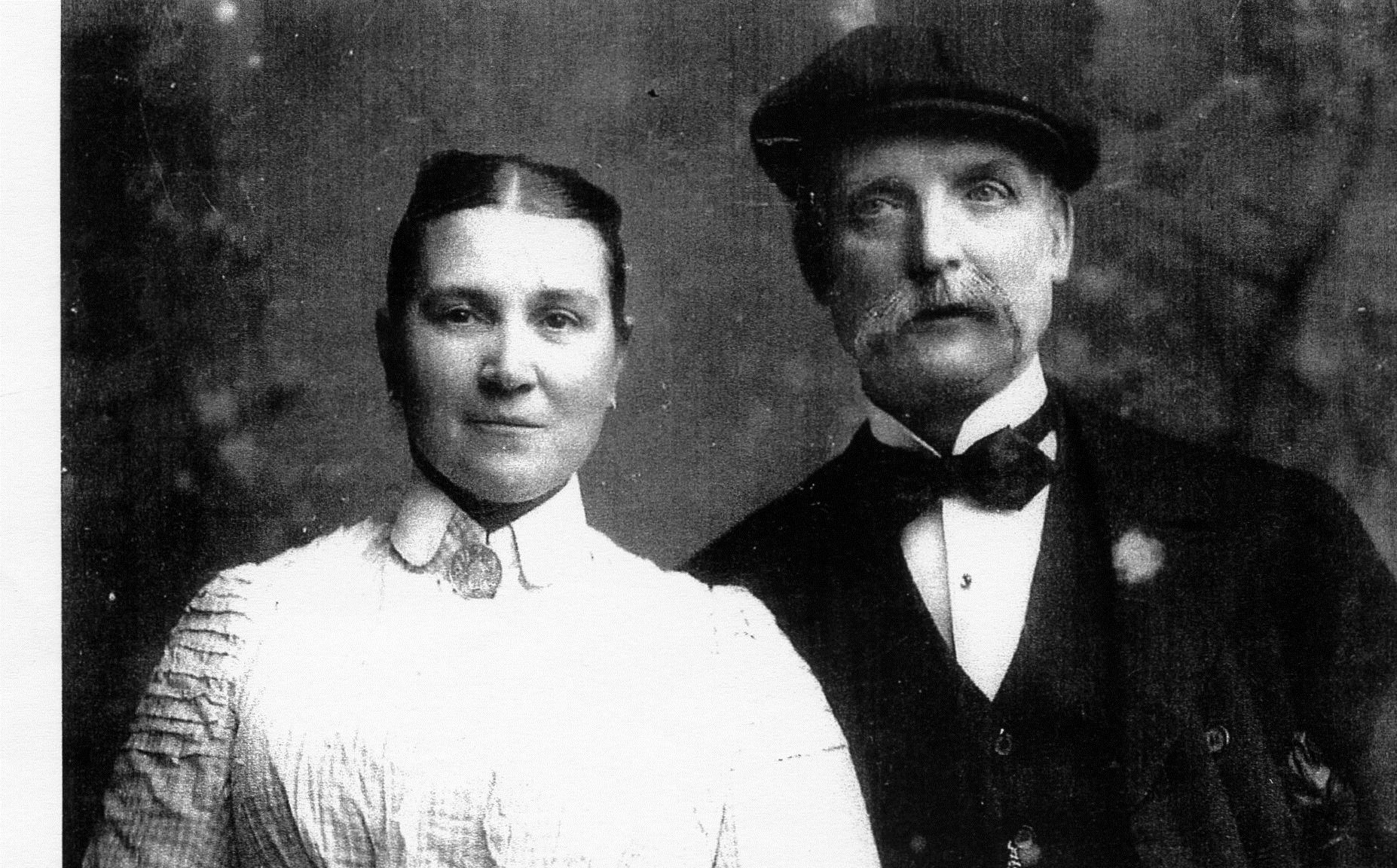
Mary Hulme and her first husband Richard Hulme
Some four years after his retirement, William Shaw passed away and went to join his God in Heaven. The end came on Friday 4th June 1926 at the Cottage Hospital after a long illness. His funeral was indeed a memorable event with crowds lining the route from his home in Waterloo Road, to the Mersey Mission church and thence to the cemetery where he was laid to rest with his beloved first wife Mary. The church itself had been completely filled and a great man`s life had been fittingly celebrated and remembered with joy, happiness and glory. He had passed on to receive his reward for many years of faithful service. A remarkable legacy for all his descendants including Jean Popplewell, Peter Shaw and their Children and Grand Children.
In closing my talk I call to mind an observation made by Runcorn`s well known historian Bert Starkey in one of his books when he said, “if ever a man deserved to be remembered it was William Shaw”. So, tonight we remember him.